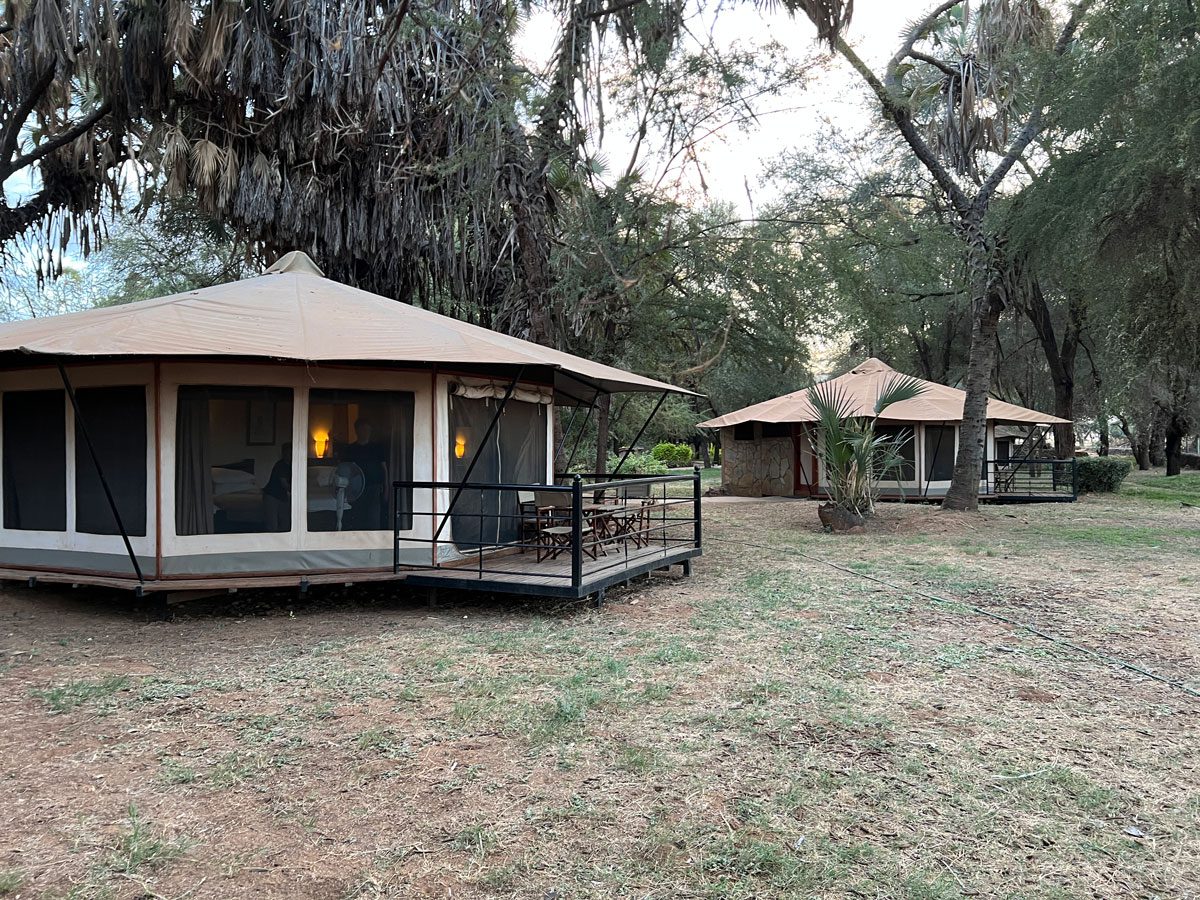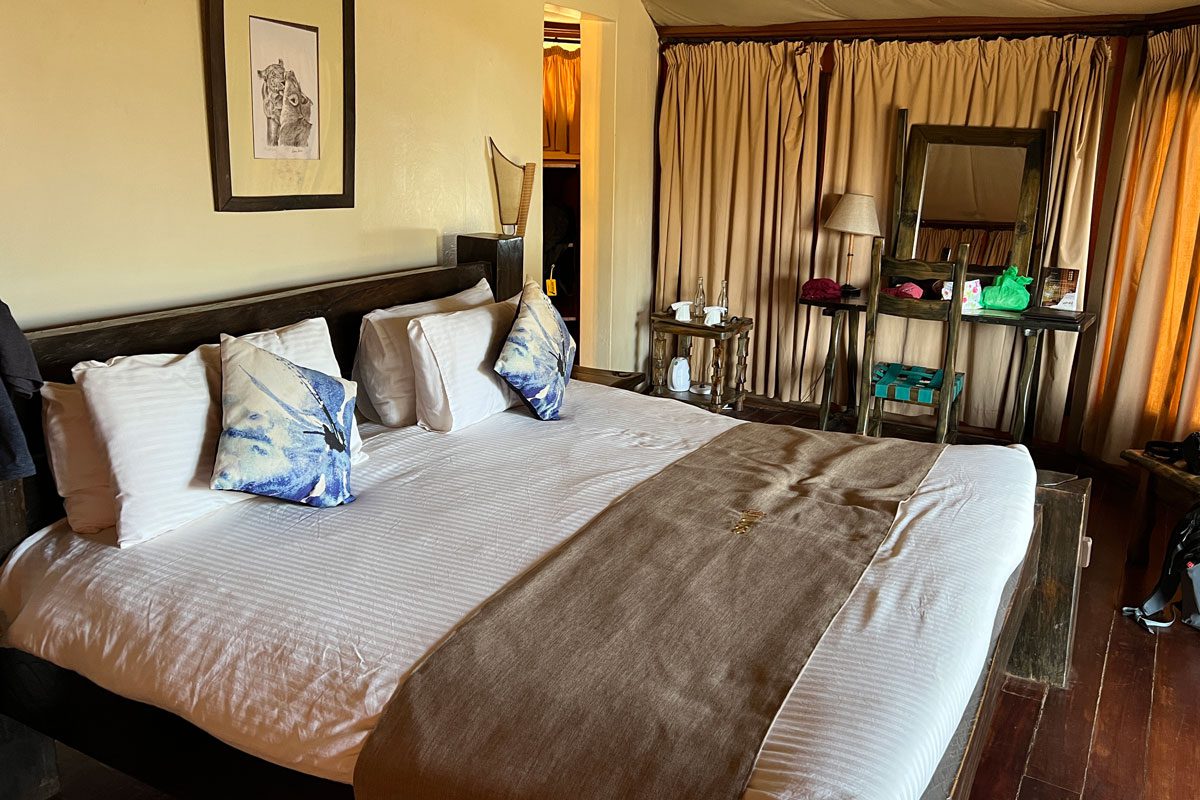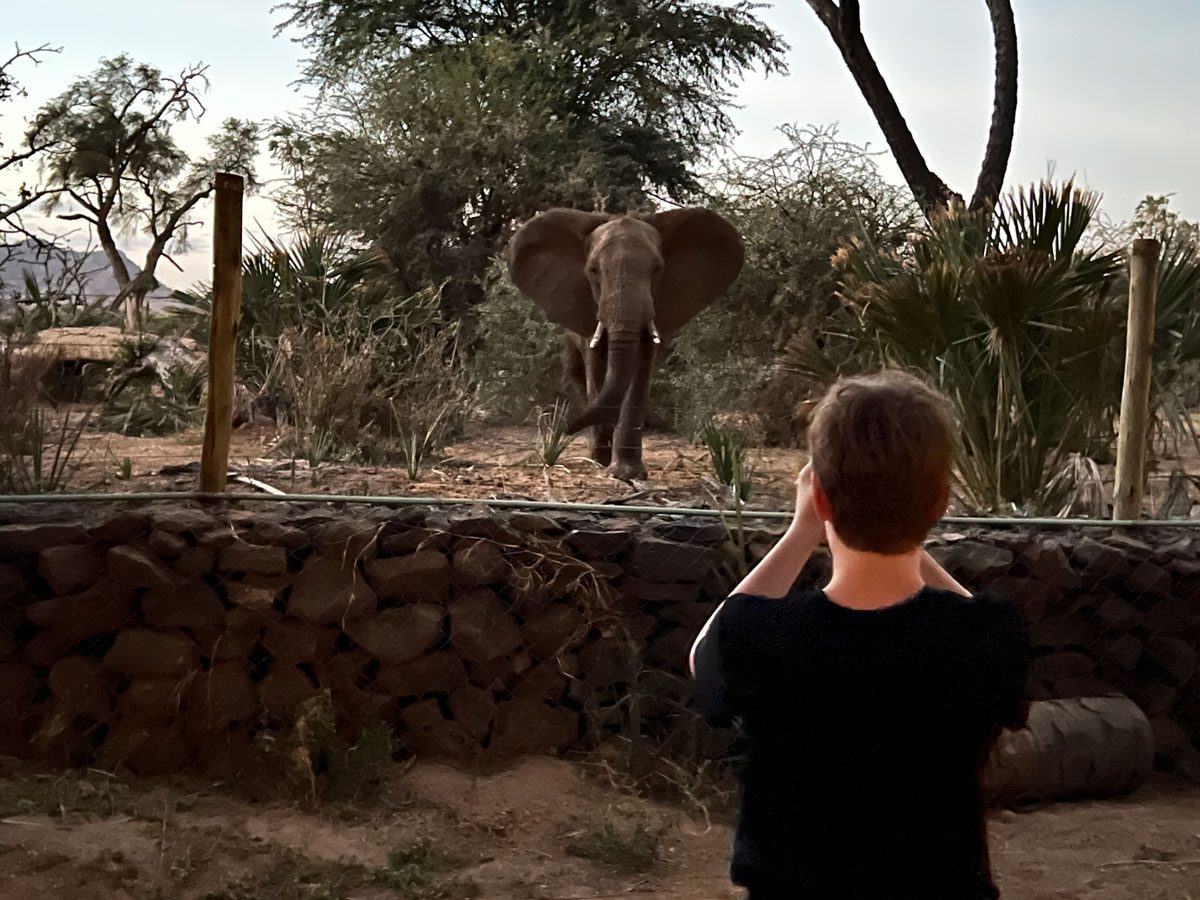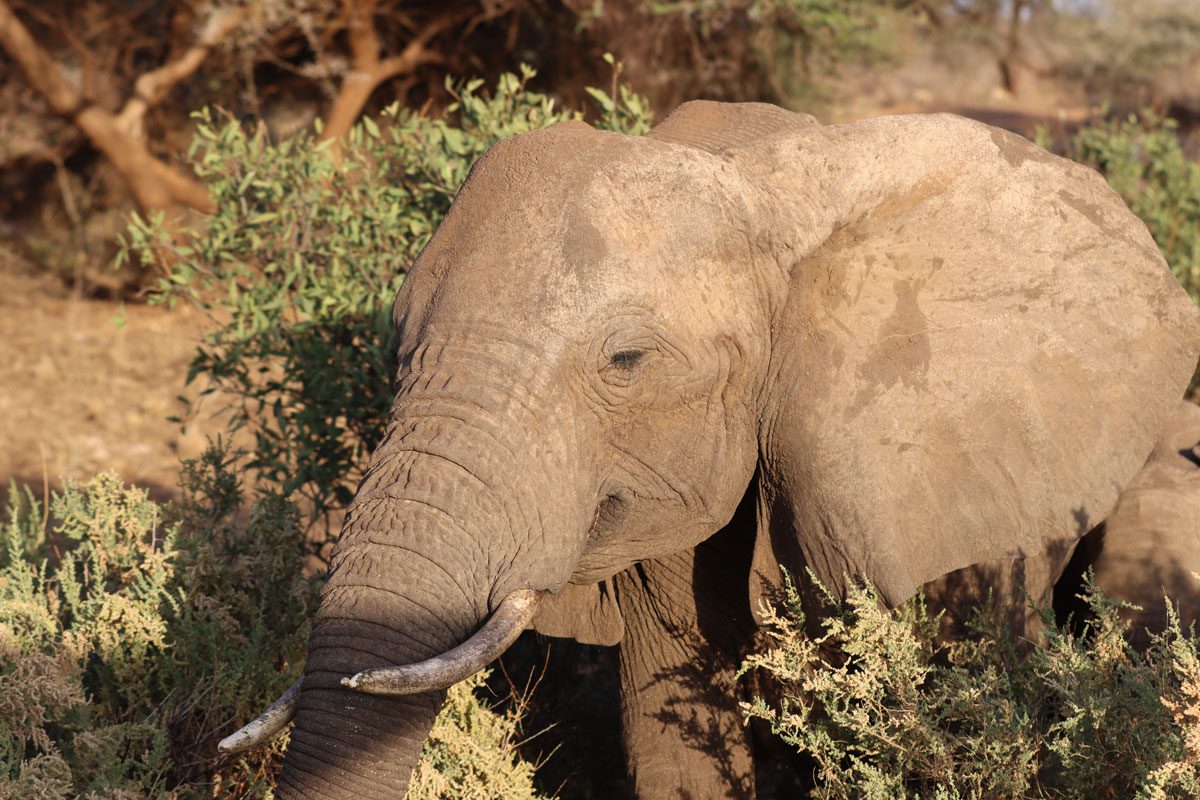
Samburu National Reserve and Buffalo Springs are two absolutely spectacular safari destinations in Africa.
Located in Northern Kenya along the banks of the Ewaso Ngiro River, these two reserves are home to a magnificent elephant population (over 900!), Africa’s elusive wild dogs and to all three of Kenya’s sought-after Big Cats (lions, leopards and cheetahs.) It is also home to a unique mix of rare and endangered wildlife like the Somali Ostrich, Grevy’s Zebra, Reticulated Giraffe, Beisa Oryx and more. This is some of Kenya’s most treasured wilderness land and one of the most famous safari destinations in East Africa.
In the Summer of 2022, our family was able to explore Samburu National Reserve and Buffalo Springs while on safari.
And it was an Incredible Experience!
This arid, vast landscape was completely wild. The reserves’ remoteness felt a million miles away from any human influence. And the harsh, dry environment left me pondering how any animal could survive.
And yet, Samburu and Buffalo Springs were absolutely full of life. From the tiny, adorable Dik-Diks (yes, that is their actual name) to the tall, gorgeous reticulated giraffes, life was everywhere we looked.
But aside from the vast array of life, what surprised me the most here, was the elephants. Here in Samburu and Buffalo Springs, the large herds of elephants were unlike any I’d ever seen. They seemed so calm and unafraid of our presence, and they casually walked within inches of our vehicle!
It was an mind-blowing experience unlike any other!
In This Post
In this post, I’d love to share with you our top safari experiences (like the one above), what we learned while visiting these reserves, provide helpful safari tips for your trip and show you why we honestly think a safari in Samburu National Reserve and Buffalo Springs is an Premier Bucket List Experience in Africa that you won’t want to miss.
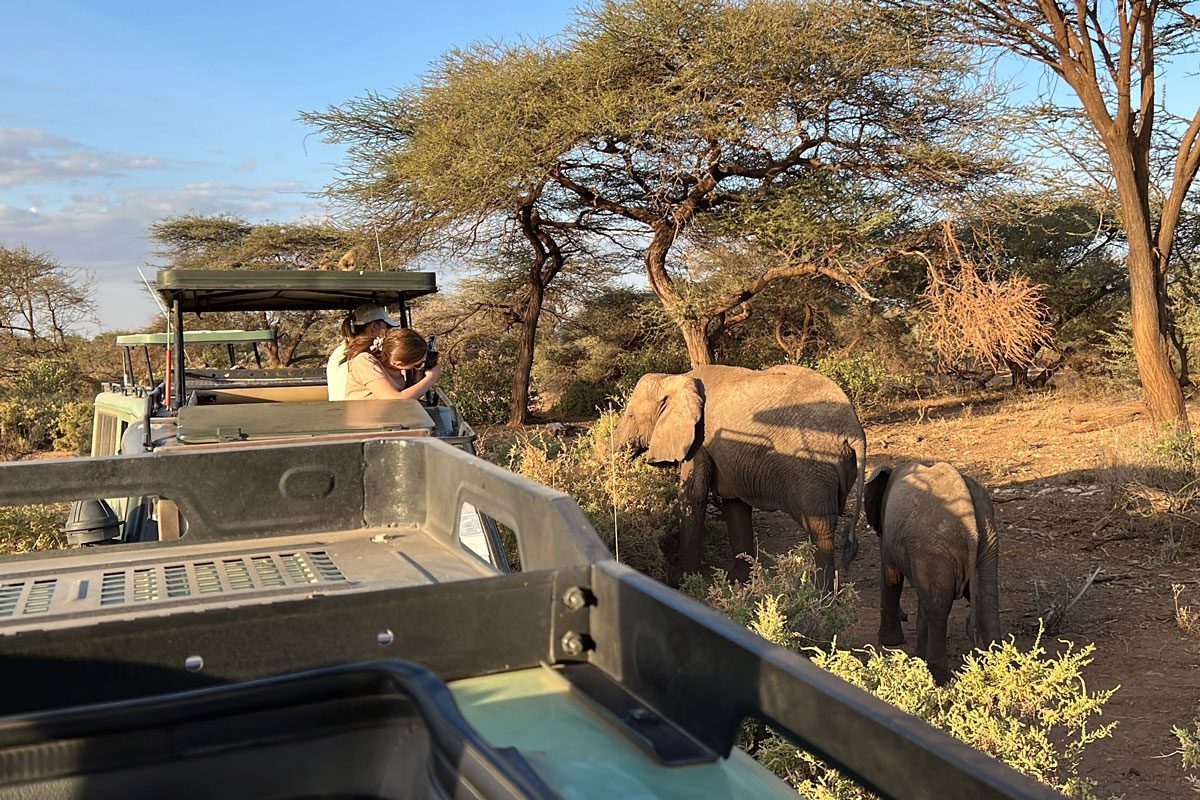
WHERE IS SAMBURU & BUFFALO SPRINGS?
Information for Your Trip:
Samburu National Reserve and Buffalo Springs are located in Northern Kenya, about 320km (200 miles) north of Nairobi. This is a full-day drive. (Google Maps says 6 hours, but with stops it will probably take most of the day.)
If you are traveling from Nairobi, you will come to Buffalo Springs first. Buffalo Springs National Reserve lies on the south side of the Ewaso Ngiro River and covers 131 square kilometers (or over 32,000 acres) of land.
Whereas, Samburu lies on the north side of the Ewaso Ngiro River. And here, it covers an area of 165 square kilometers (or over 40,000 acres.)
Out of the two reserves, Samburu National Reserve is considered the more famous safari destination. And while Samburu does have a more interesting and varied landscape than Buffalo Springs, in reality the only reason that there are two different reserve names is that the reserve land here falls into two different counties.
During our visit, we found that the name Samburu tended to be generically used when talking about both of these reserves, and even our camp, Ashnil Samburu Camp, was actually located in Buffalo Springs.
Luckily, both Samburu and Buffalo Springs can easily be seen together on safari during the dry season, so there is no need to have to choose one over the other. They are both fantastic safari destinations!
WHEN IS THE DRY SEASON AT SAMBURU?
- June-October & December-March
- The dry season is considered the best time to see wildlife here.
- Our family visited during July.
SAMBURU NATIONAL RESERVE & BUFFALO SPRINGS MORNING SAFARI
Our family arrived at Samburu in the evening, after spending most of the day driving from Nairobi. We went straight to our camp, located within Buffalo Springs Reserve, but we didn’t officially begin our safari until the following day.
The next morning we left our camp at 6:20am for our first safari in Samburu and Buffalo Springs, and we were able to catch this beautiful sunrise over the reserve. It was an incredible way to start the day!
Safari Tip: Even if you are not a morning person, try to take at least one safari drive where you can catch a sunrise. It’s so worth it!
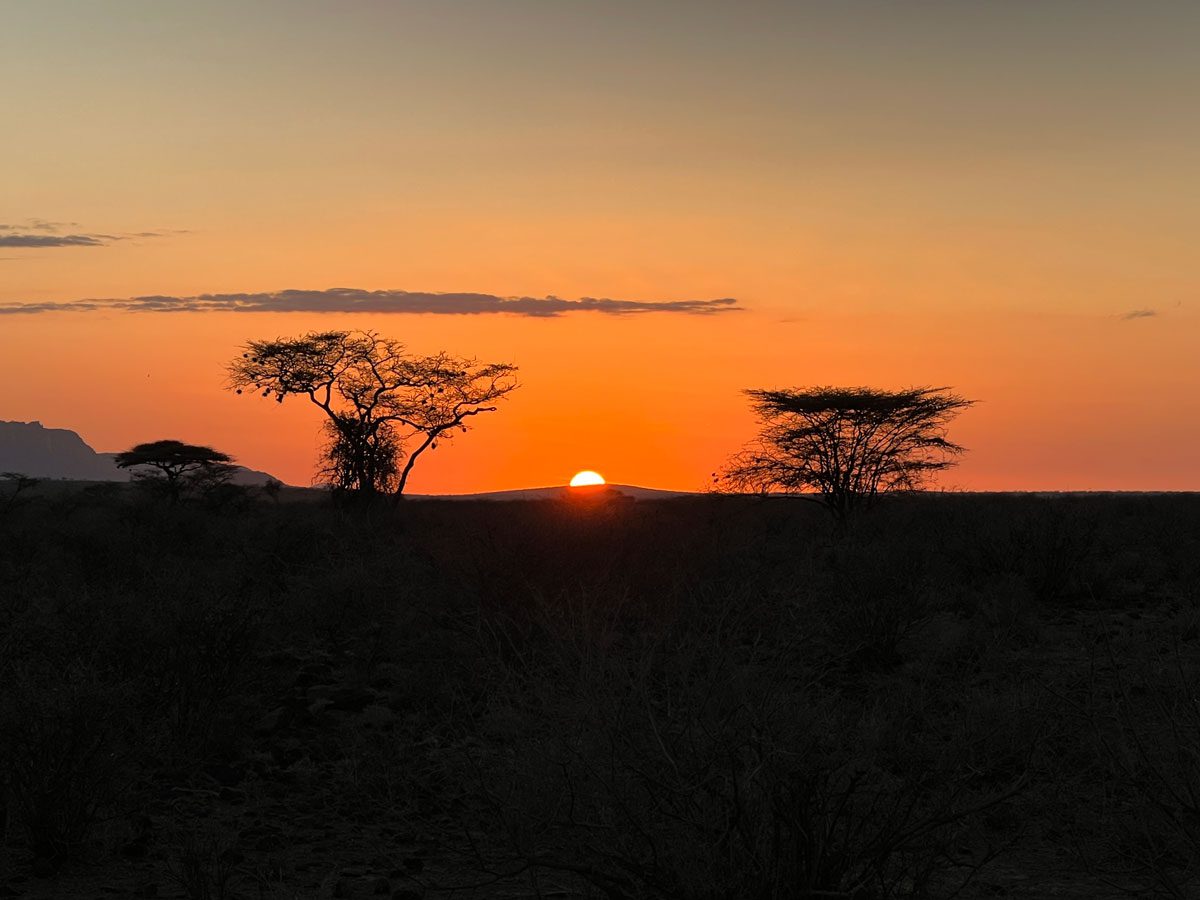
In this early morning light we also began finding our first animals. And they were practically glowing!
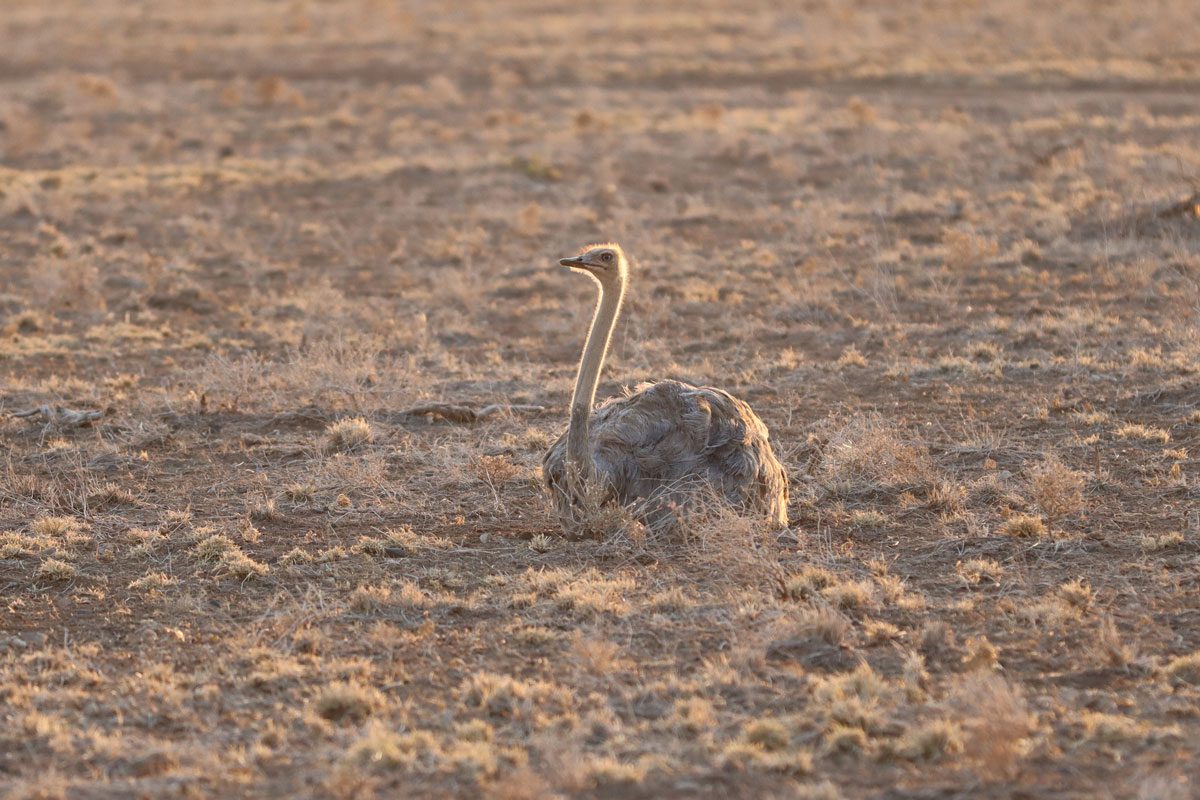
Safari Tip: Early Morning Light makes for Wonderful Pictures, especially if you can get them backlit like the ostrich above. (Yet, in low light, like before the sun has officially come up, animal photography can be quite difficult for most cameras.)
As our safari continued, we quickly realized why Samburu and Buffalo Springs are considered wildlife treasures.
There were rare and endangered species everywhere!
First we came across:
The Endangered Reticulated Giraffe.
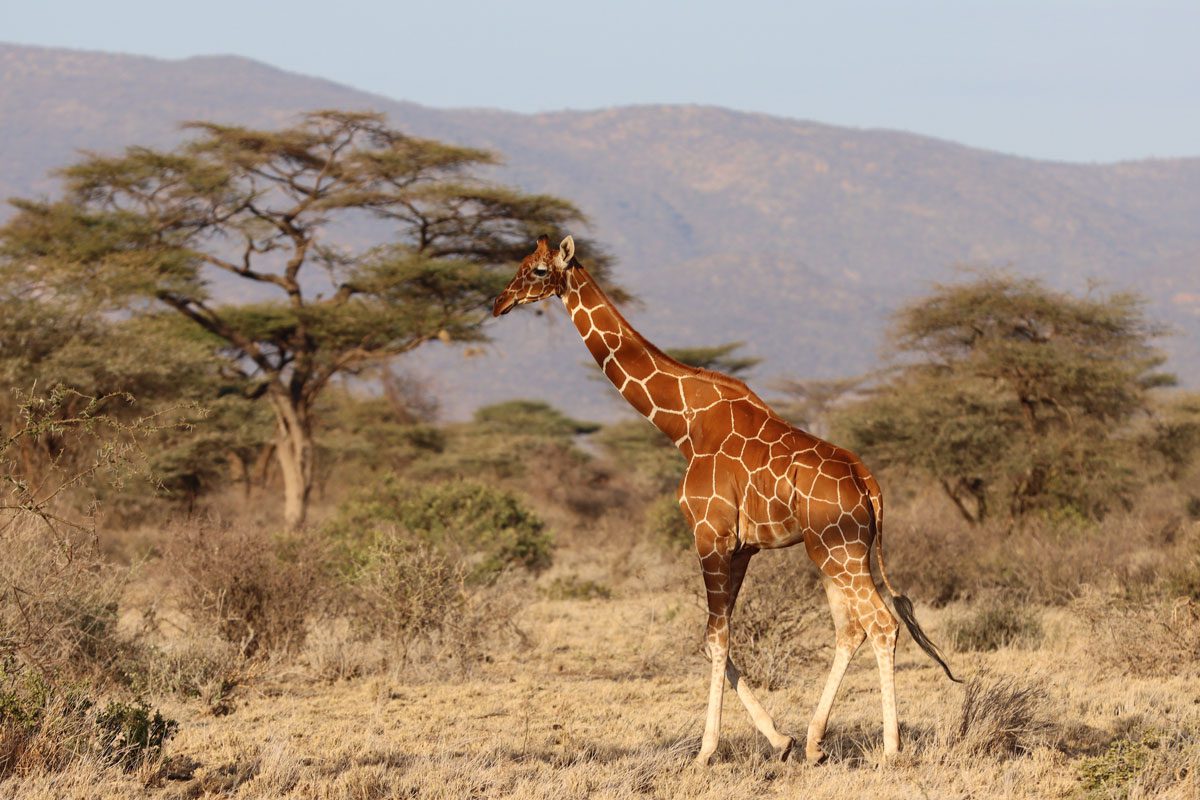
The reticulated giraffe species is very easy to distinguish from other giraffe species due to its stunning, distinct patterning. There’s no splotchy patches of color on this giraffe.
It’s also one of the most commonly seen species of giraffe in zoos across the United States, so I was very excited to see these gorgeous creatures roaming free in the wild.
Lastly, this giraffe can only be found in parts of northern and eastern Kenya, Somalia and southern Ethiopia. According to the Giraffe Conservation Foundation, there’s only about 16,000 left in the wild and so I felt truly fortunate to see them.
Safari Tip: Reticulated giraffes do not live in Kenya’s popular southern parks like Amboseli or the Masai Mara, so if you are looking to see one, Samburu National Reserve should be high up on your safari destinations list.
The Endangered Grevy’s Zebra
We also quickly found the endangered Grevy’s Zebra!
The Grevy’s Zebra is the largest of all zebras and it is easy to recognize due to it’s large ears and narrower stripes.
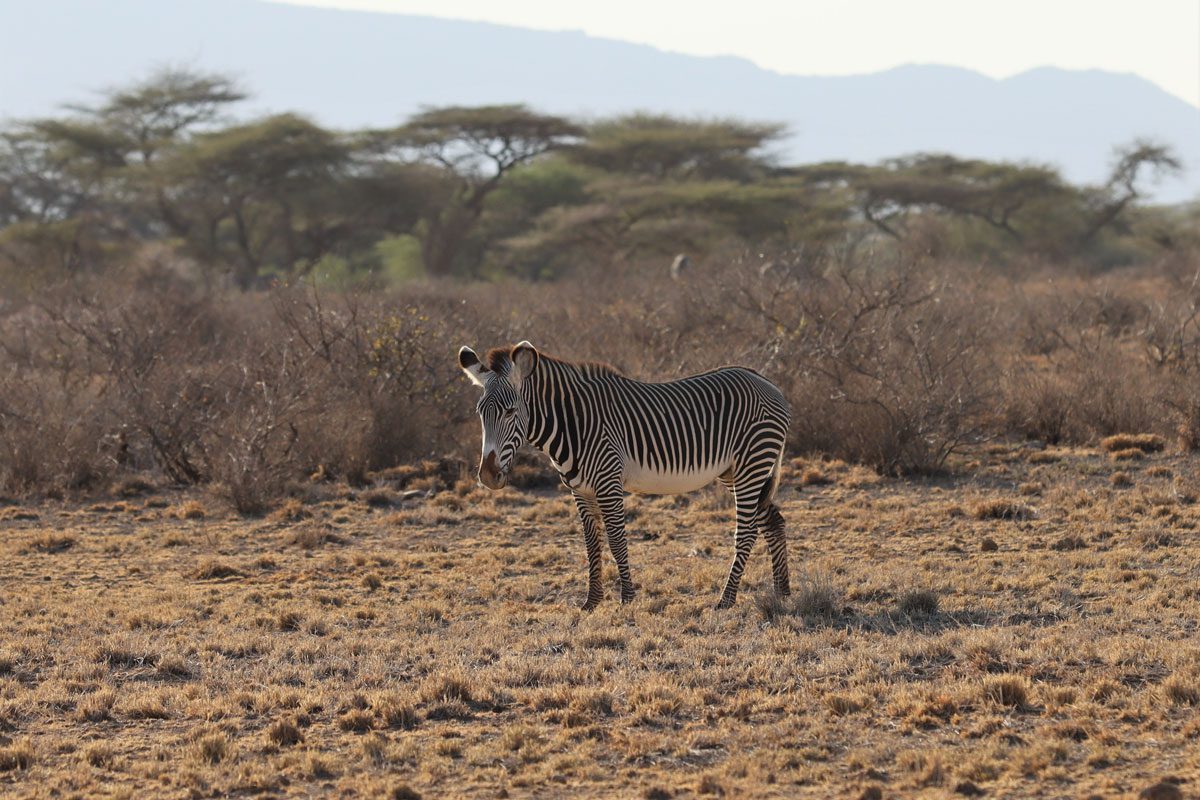
Now this was one animal that previously I had no clue of how endangered it was. And it turns out that it is one of Africa’s most endangered large mammals!
It is estimated by the IUCN Red List of Threatened Species (last assessed 2016) that there are only 1,956 mature Grevy’s Zebra left in the world, with almost all of them in located in central, northern Kenya!
Yet, another reason as to why Samburu National Reserve and Buffalo Springs are so special and considered top safari destinations.
The Endangered Beisa Oryx (or East African Oryx)
As our morning safari game run continued, we then stumbled upon this striking creature called the Beisa Oryx.
Isn’t this animal gorgeous! And those horns, they’re fantastic!
Fun Fact: Beisa Oryx horns can be over 3 feet long!
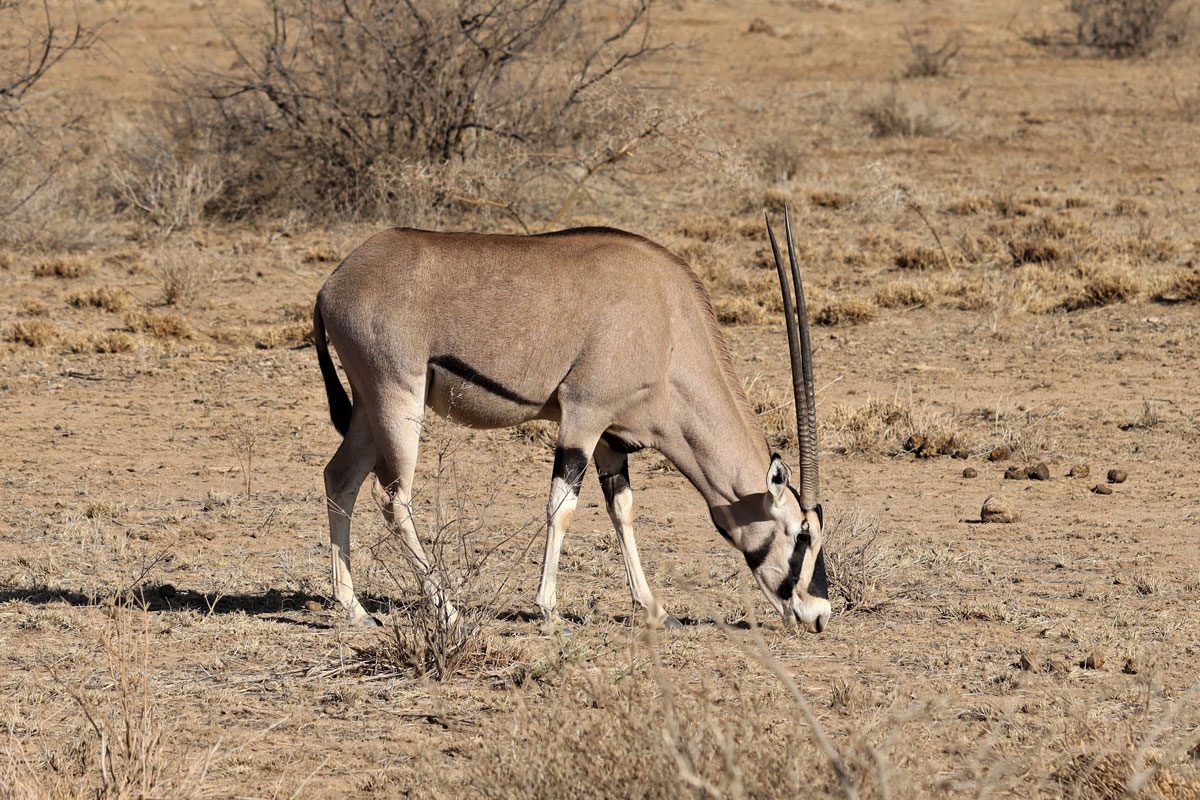
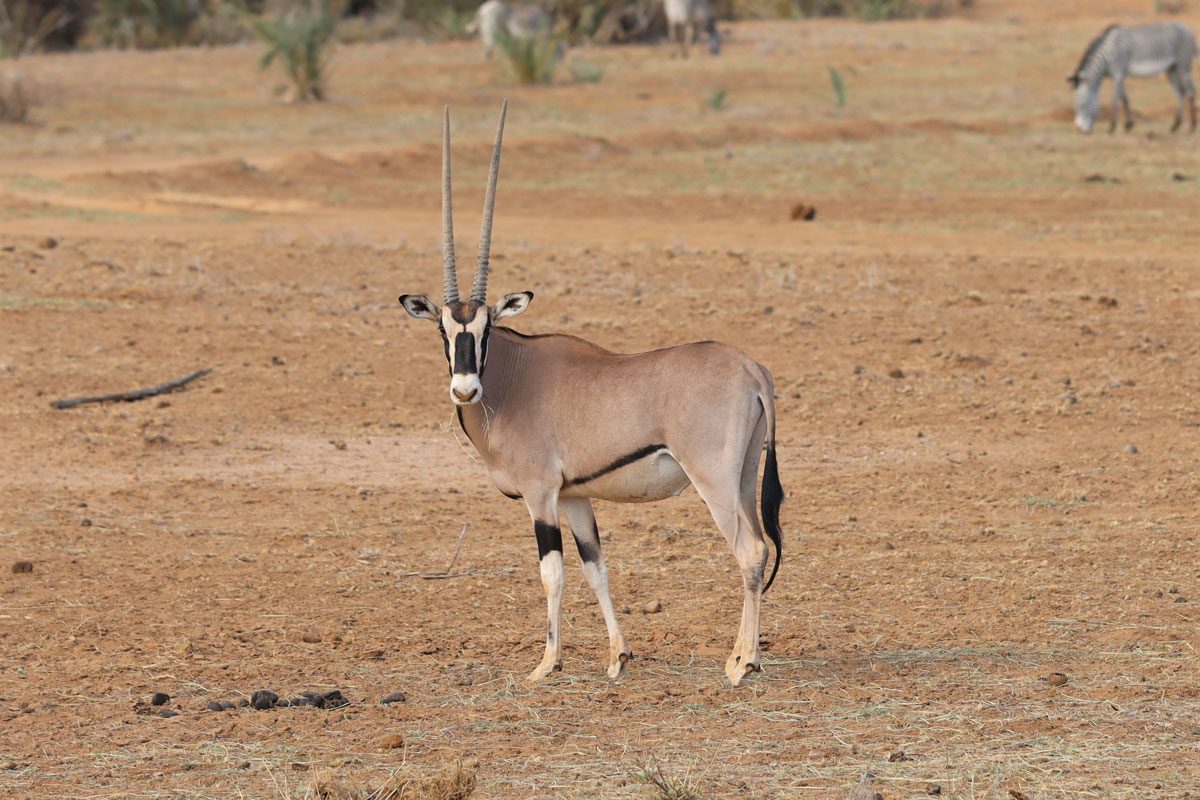
The Beisa Oryx was another creature that I previously was unaware of how endangered it was. But according to the ICUN Red List (last assessed 2018), there are only about 8-9,000 mature individuals of the Besai Oryx left in the wild and the area of Samburu is one of the few places you can find one!
Safari Tip: The Besai Oryx primarily lives in Northern/ Eastern Kenya, parts of Ethiopia and South Sudan, so Samburu National Reserve is a fantastic place to see one.
Warthogs
Along with seeing three endangered animals within the first hour of our safari, we also saw a fantastic warthog head-butting dominance scuffle.
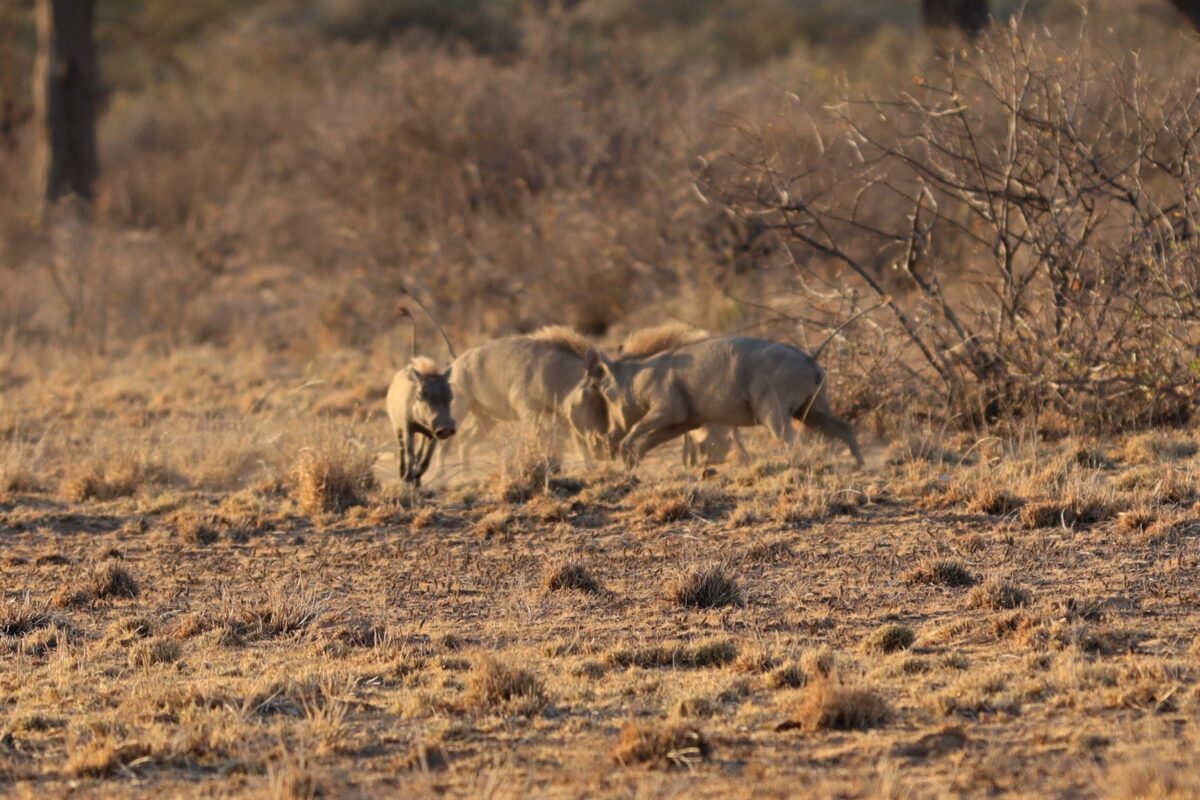
These warthogs were fascinating to watch. But once the scuffle ended they quickly trotted off into the bush with their little tails held high in the air. (The way a warthog runs, with their tails sticking straight up, is really funny to watch.)
The Endangered African Savannah Elephant
And then we found Samburu’s magnificent elephants!
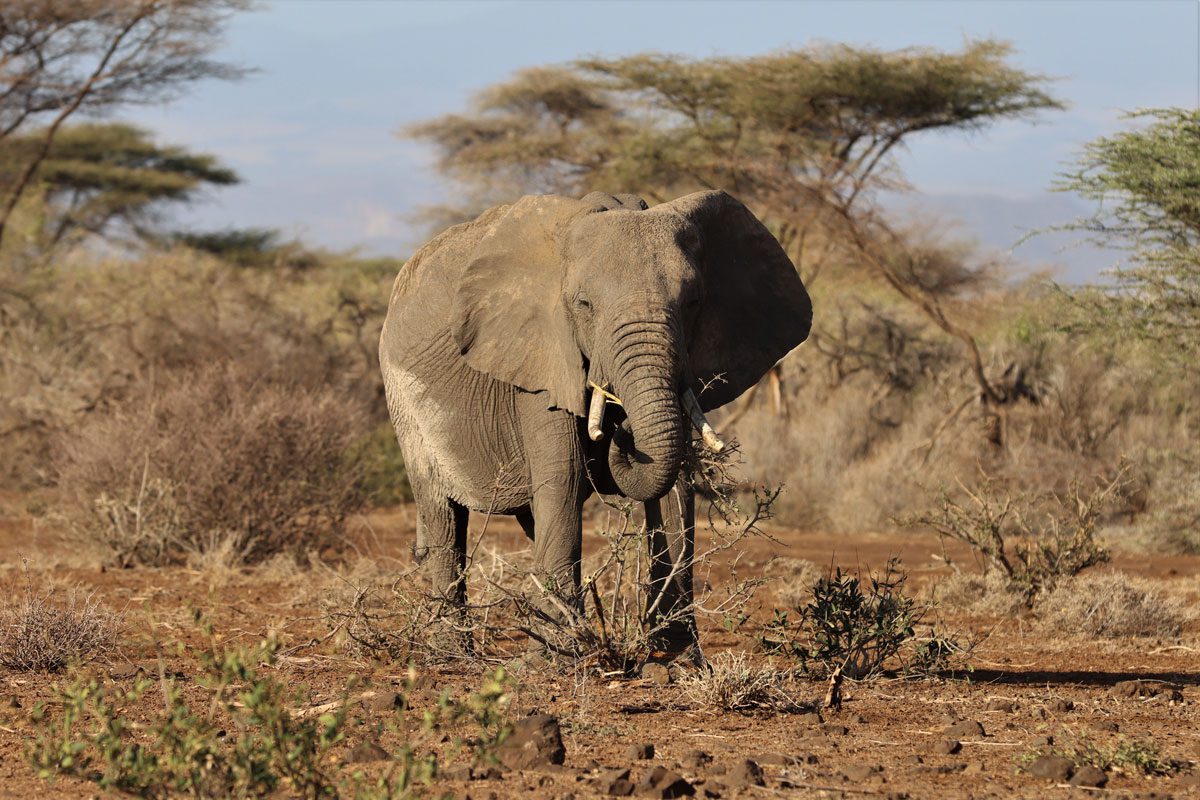
Seeing the African Savannah Elephant is a true bucket-list safari sight. And they are huge! The African Elephant is the World’s Largest Land Animal and can weigh up to 6.6 tons. They are intelligent, sociable and familial animals as well.
Yet sadly, the African Savannah Elephant’s population is still decreasing globally and they continue to remain in the Endangered Status according to the IUCN Red List of Threatened Species (last assessed 2020.)
But fortunately, their population in Samburu has been increasing in recent years thanks to some pretty amazing conservation efforts.
With this in mind, we were so happy to see several very young (and completely adorable) baby elephants during our time in Samburu and Buffalo Springs.
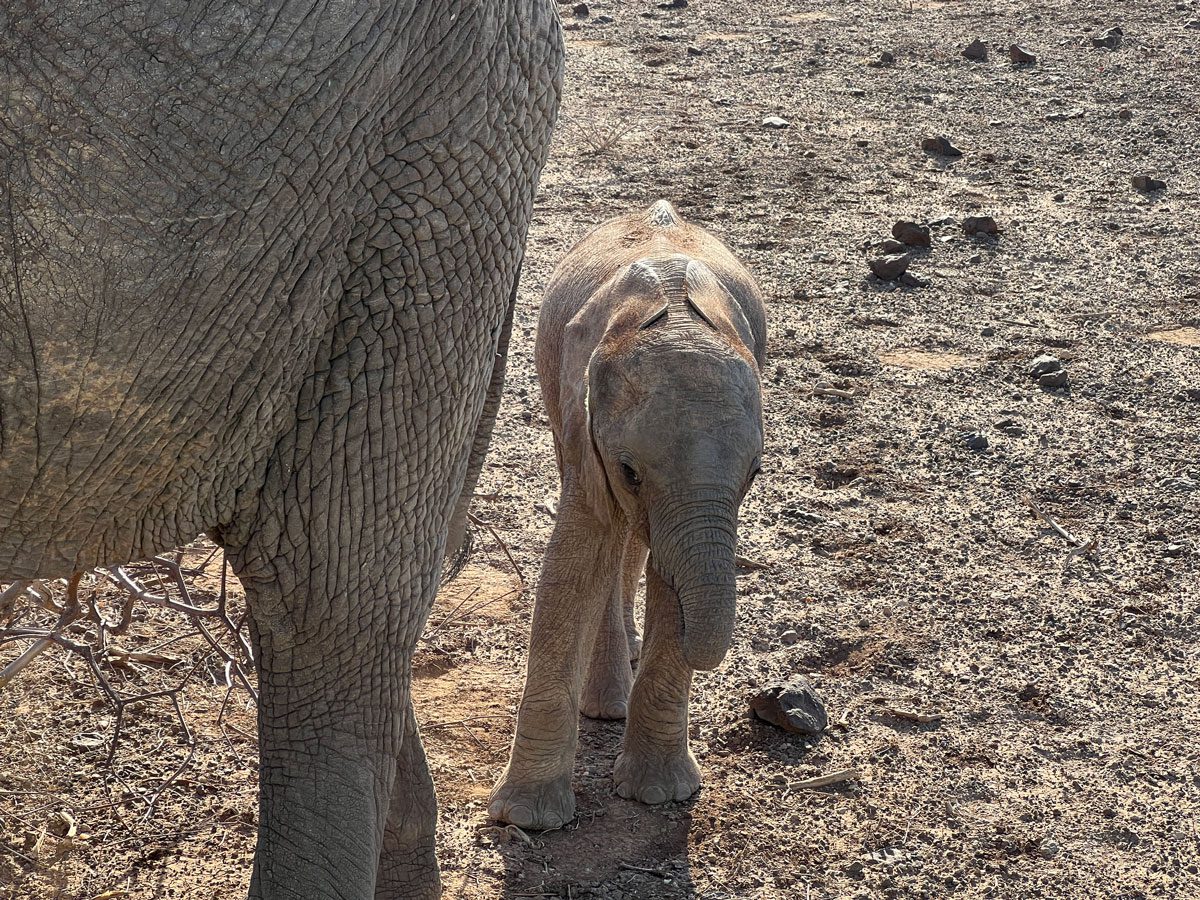
Our First Elephant Encounter in Samburu
This morning safari was our first encounter with Samburu’s elephants and honestly I had no idea of what to expect.
When we found them, our guide simply parked our vehicle, near but not intruding, to where a small herd of about 10 elephants were grazing at some bushes. Here we just sat, quietly watched them and of course took a ton of pictures!
As they grazed I noticed that slowly they were starting to move closer and closer to where our vehicle was sitting, until several wild elephants were literally standing right next to our vehicle!
I couldn’t believe it!
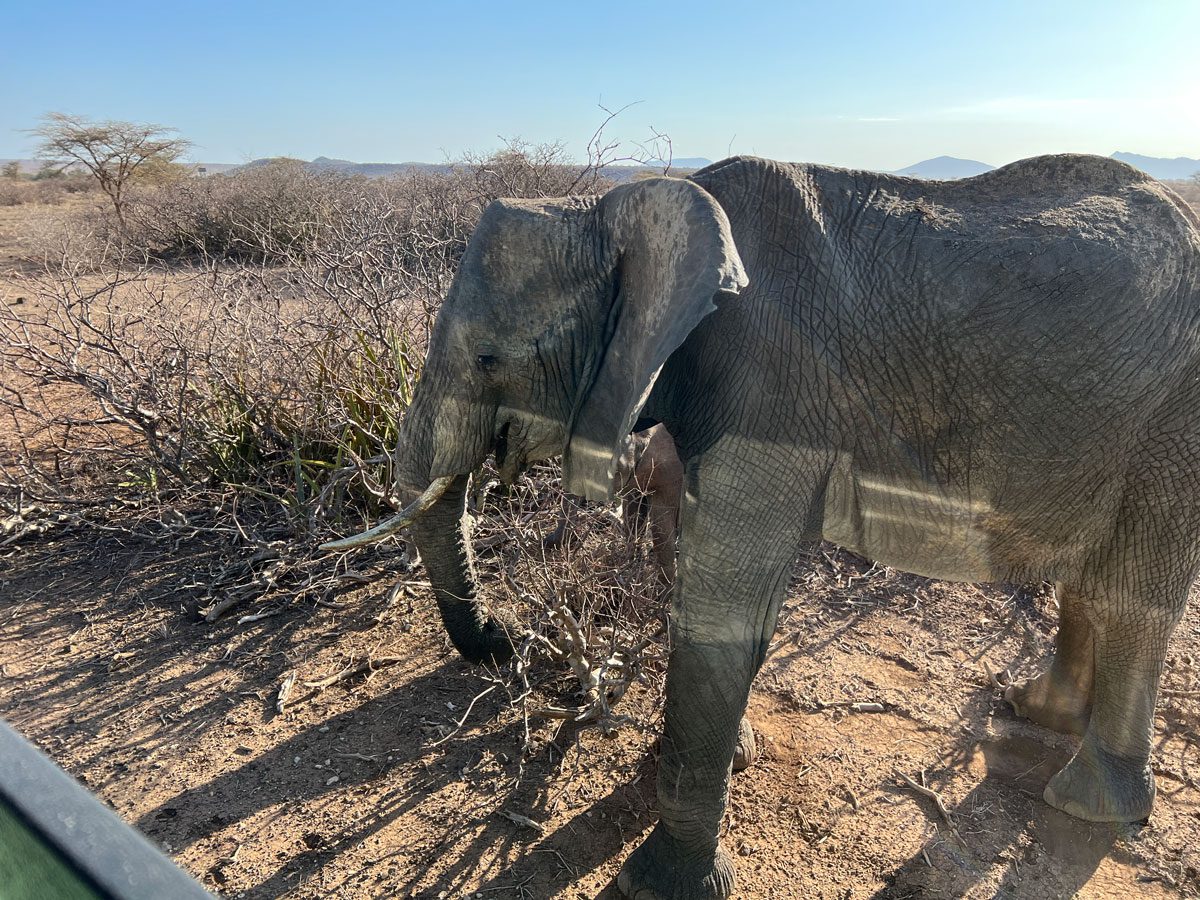
The Elephants Were So Close!
Then they began casually walking between and around our three safari vehicles as they made their way towards the nearby trees.
This was closer than I had ever imagined we’d be to wild elephants.
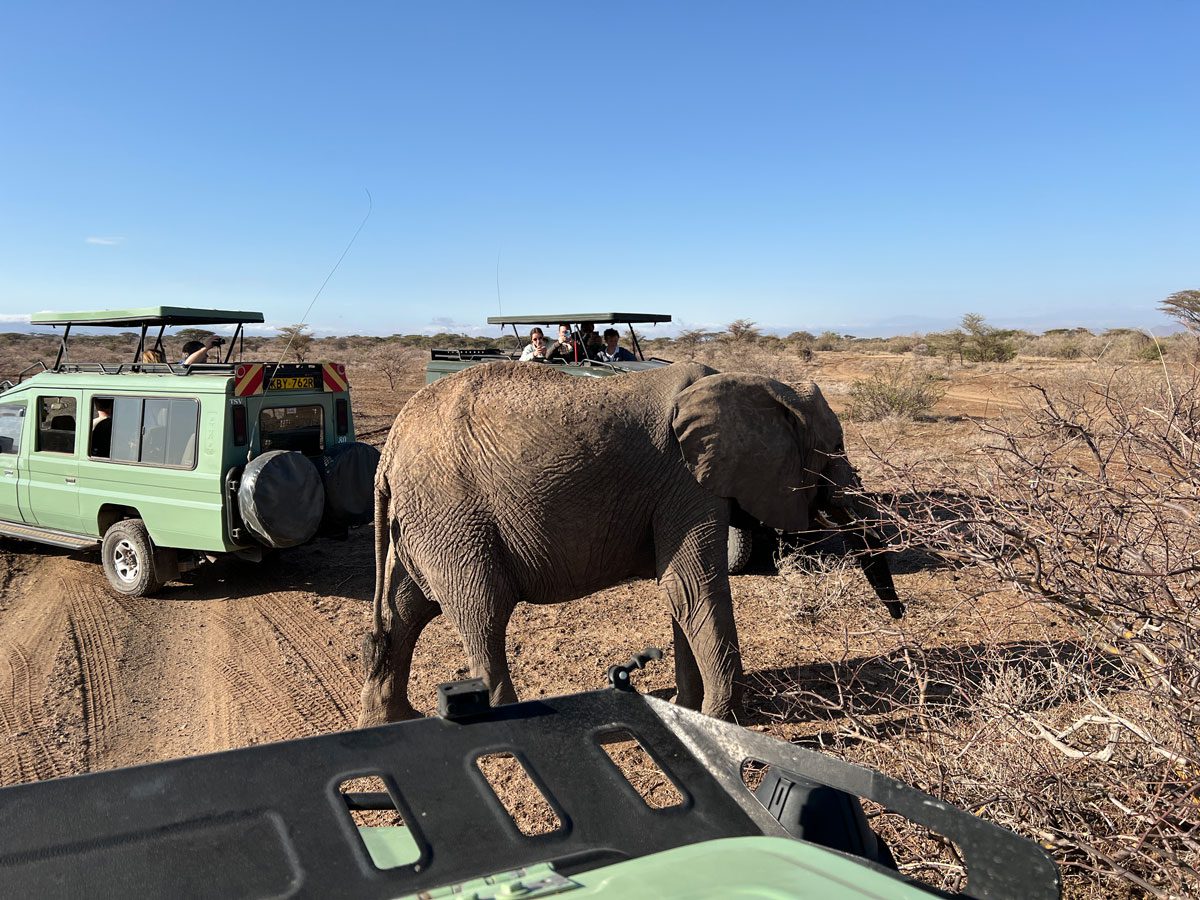
Now at first I was really nervous because I’ve seen several videos with elephants charging safari vans, but our guide said that here we were ok and I trusted him.
At the same time, I did notice that these elephants in front of us didn’t seem to mind our presence at all. In fact, they looked completely relaxed, happy and appeared to be practically smiling at us (at least that’s what it looked like to me.)
And as we exchanged gazes, (yes, they were that close) it really felt like they wanted to get to know us as well.
Having this brief “Moment” with a wild elephant was an absolutely amazing experience!
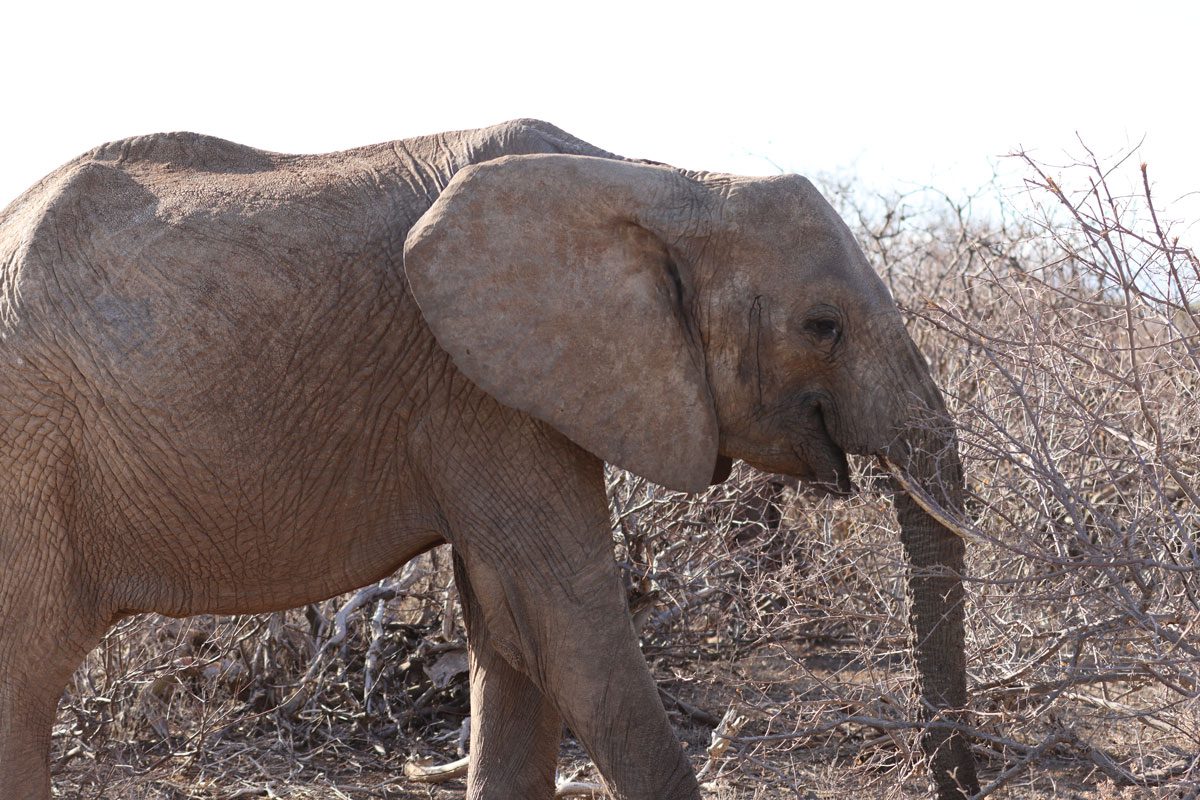
Yet, I still kept in mind that we needed to be cautious around these enormous creatures, because accidently agitating any of these individuals could quickly lead to a very bad day.
Samburu’s elephants’ temperament honestly surprised me and I was instantly intrigued as to why, so I asked around.
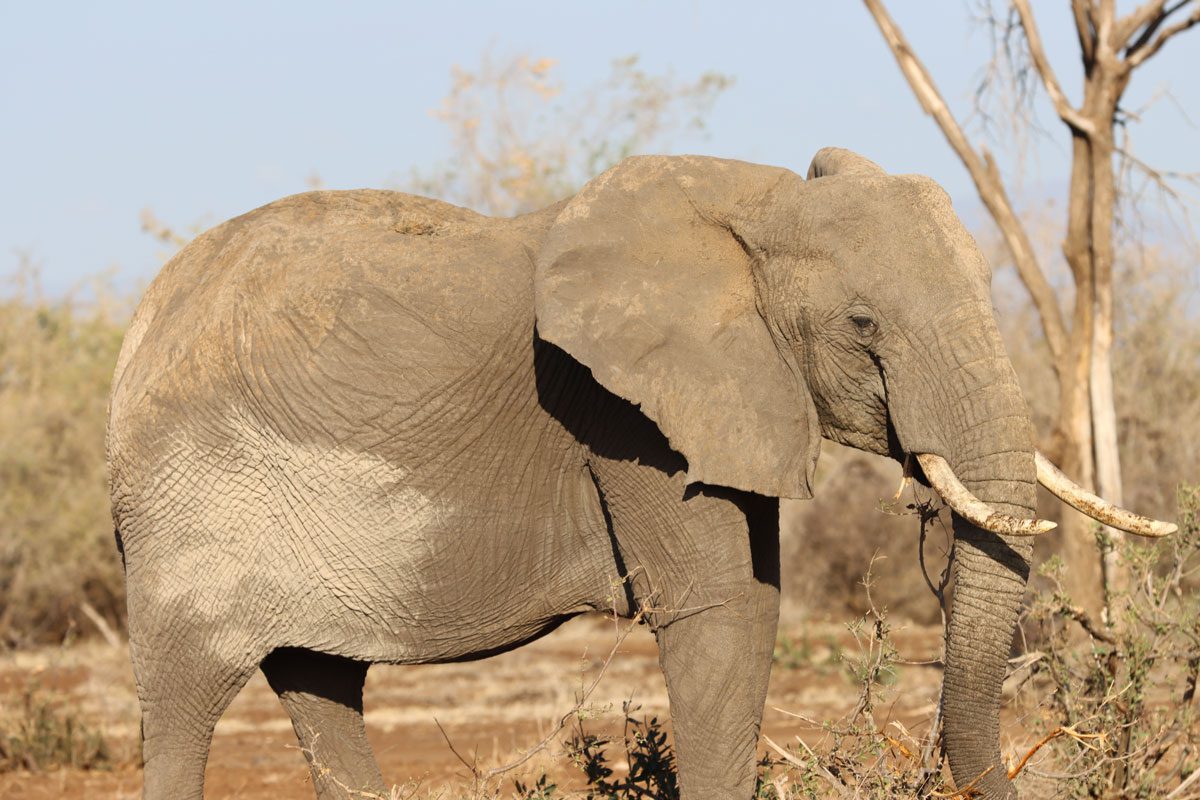
What’s Different About Samburu’s Elephants?
Our guide told us that in many African parks, it is true that you can’t get anywhere near the elephants because they will in fact charge. And that letting any of those wild elephants close to your vehicle would be very dangerous. But here in Samburu, the elephants are somewhat different.
I was told of several possible reasons for this difference.
First, the elephants here don’t know poaching like some of the elephants in other parks do, and so in turn they don’t tend to see people as an immediate threat.
Second, the Save the Elephants Research Camp is located here in Samburu. This is the hub of one of the world’s leading elephant research group. And therefore the elephants, that are permanent residents here, are very used to being observed.
Scientist have logged literally thousands of hours studying these Samburu elephants, in order to learn how to better protect their species and their habitat. And so these elephants are pretty used to seeing research vehicles and having people quietly watch them.
I was amazed to learn this about the Samburu elephants. And I was completely ecstatic with our fantastic elephant experience in Samburu!
Safari Tip: Know that each elephant herd in Samburu will behave differently and that every safari experience is different. This was just our experience in Samburu. But I hope that you can have an amazing elephant experience too!
ASHNIL SAMBURU CAMP
At 9am we headed back to our lodge at Ashnil Samburu Camp for a late breakfast. It was hard to believe that we had seen all of that in in just 2 1/2 hours!
After breakfast, we rested, did some hand-washing and relaxed for a little in our fantastic “camp” accommodations!
(which we highly recommend!)
After lunch, our schedule first took us to the nearby Samburu Tribe Village (which was wonderful) and then on a second safari drive while coming back to the camp. (In this post, I’m only concentrating on our safari drives and the animals in this area.)
A LATE AFTERNOON SAFARI IN SAMBURU
Our afternoon safari in Samburu, began similar to that of our morning safari, with immediately seeing some more of Samburu’s rare and endangered animals. Our first new species was
The Near Threatened Gerenuk
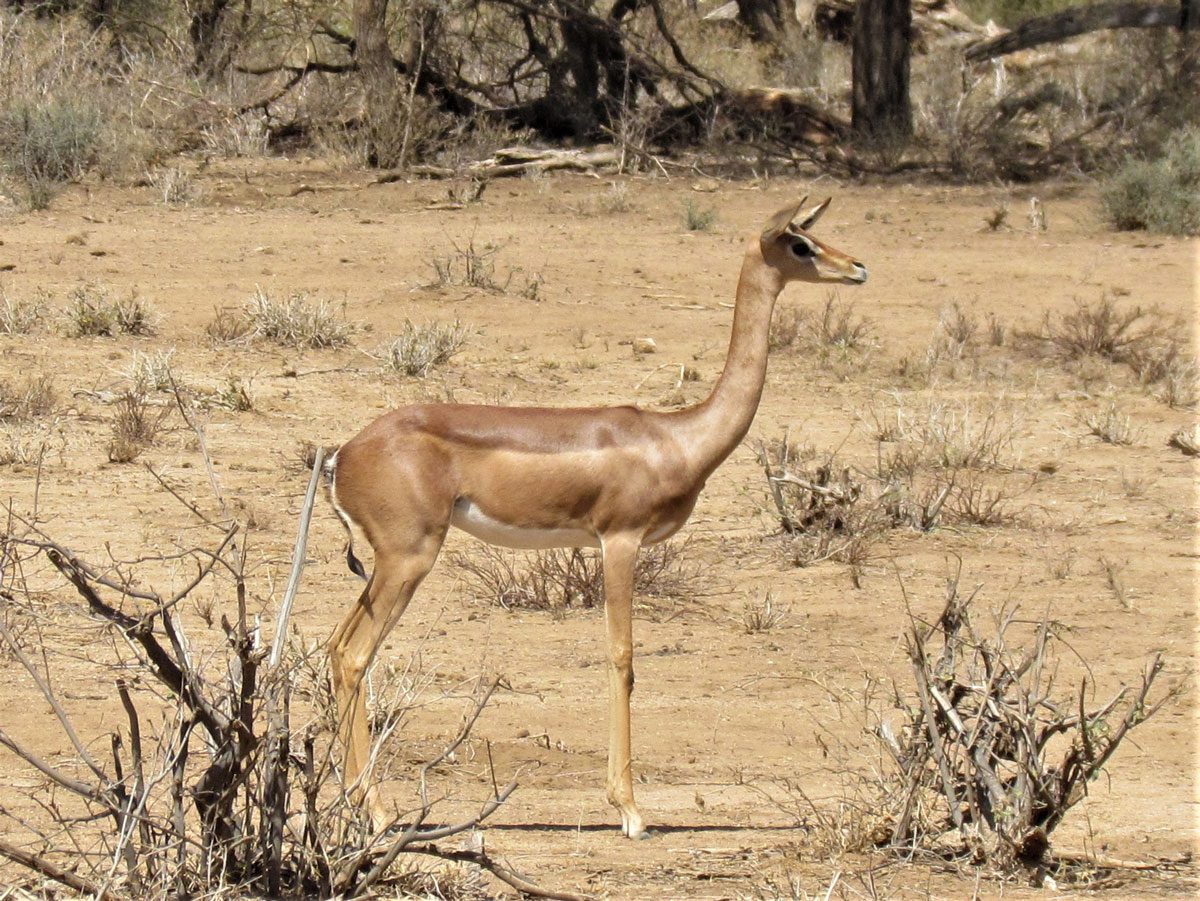
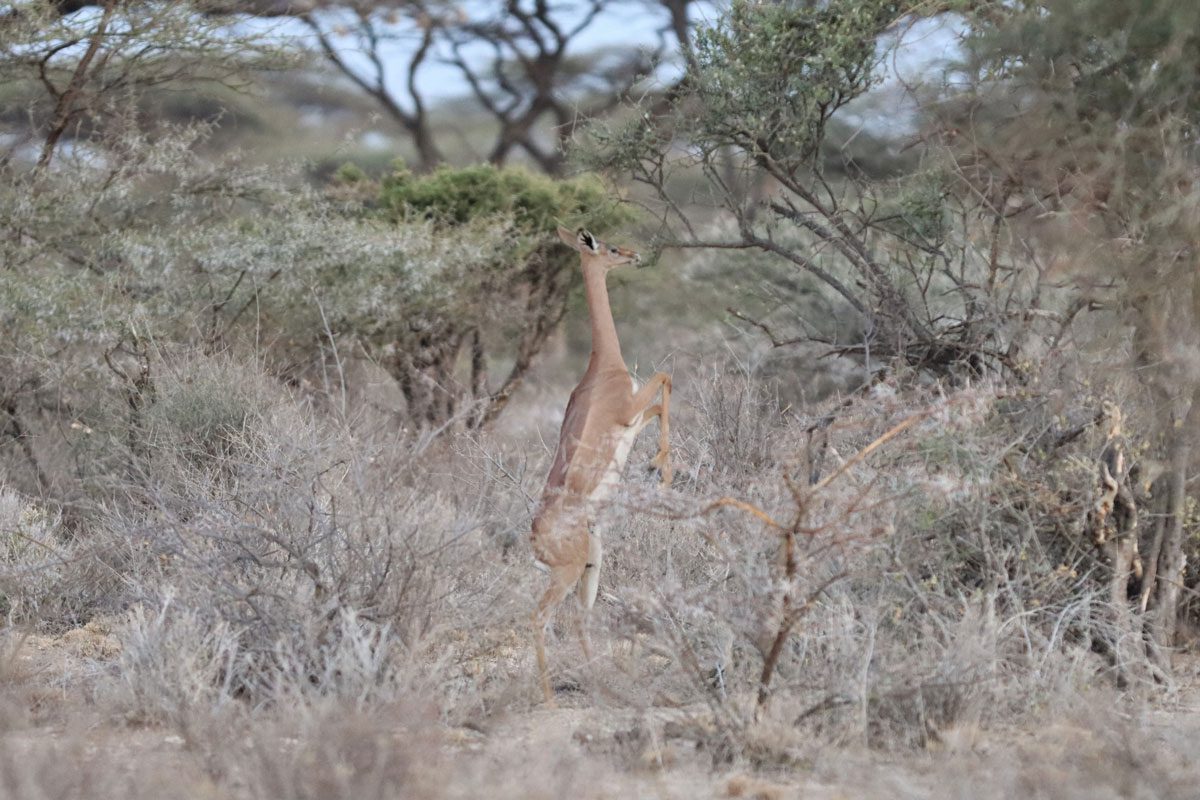
The gerenuk, who’s name means “giraffe-necked” in Somali, is a fascinating long-necked antelope that often dines while balanced on its hind legs in order to reach the leaves high up in the bushes that most other animals cannot reach.
Below is an example of the type of plants that a gerenuk feeds on. This is an acacia bush. Look at the size of those thorns! That does not look like a fun dining experience to me.
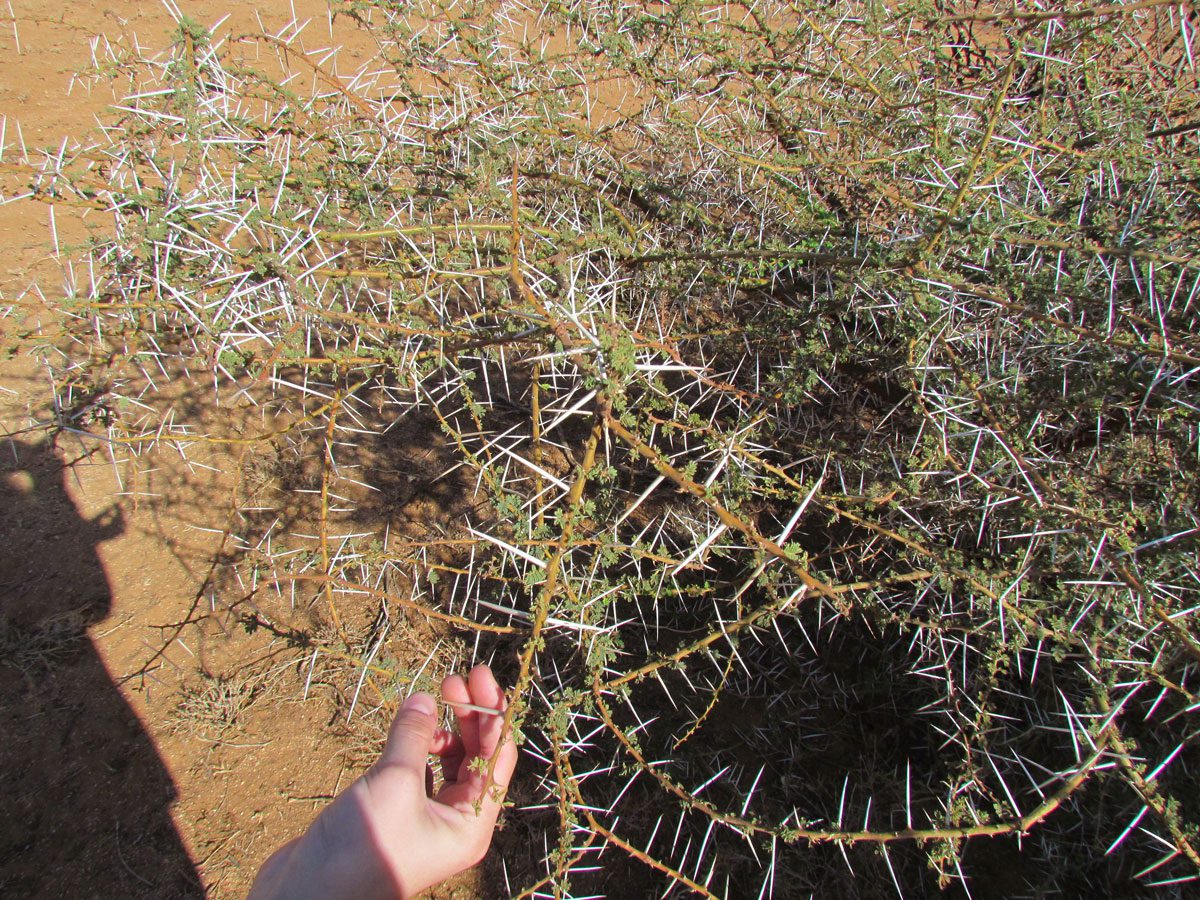
Safari Tip: Acacia bushes and trees are all over Africa. When on safari, if you are standing as you drive through the parks or have your window open while sitting, it’s always a good idea to be aware of any acacia branches extending out into the road, because you definitely don’t want to get hit in the face with one of these branches if your vehicle accidently brushes up against this thorny plant. (The guides are great at avoiding these branches, but it never hurts to keep an eye out as well.)
MORE ANIMALS YOU MAY ENCOUNTER IN SAMBURU & BUFFALO SPRINGS
(Plus What They Look Like)
So You Can Identify Them Like a Pro!
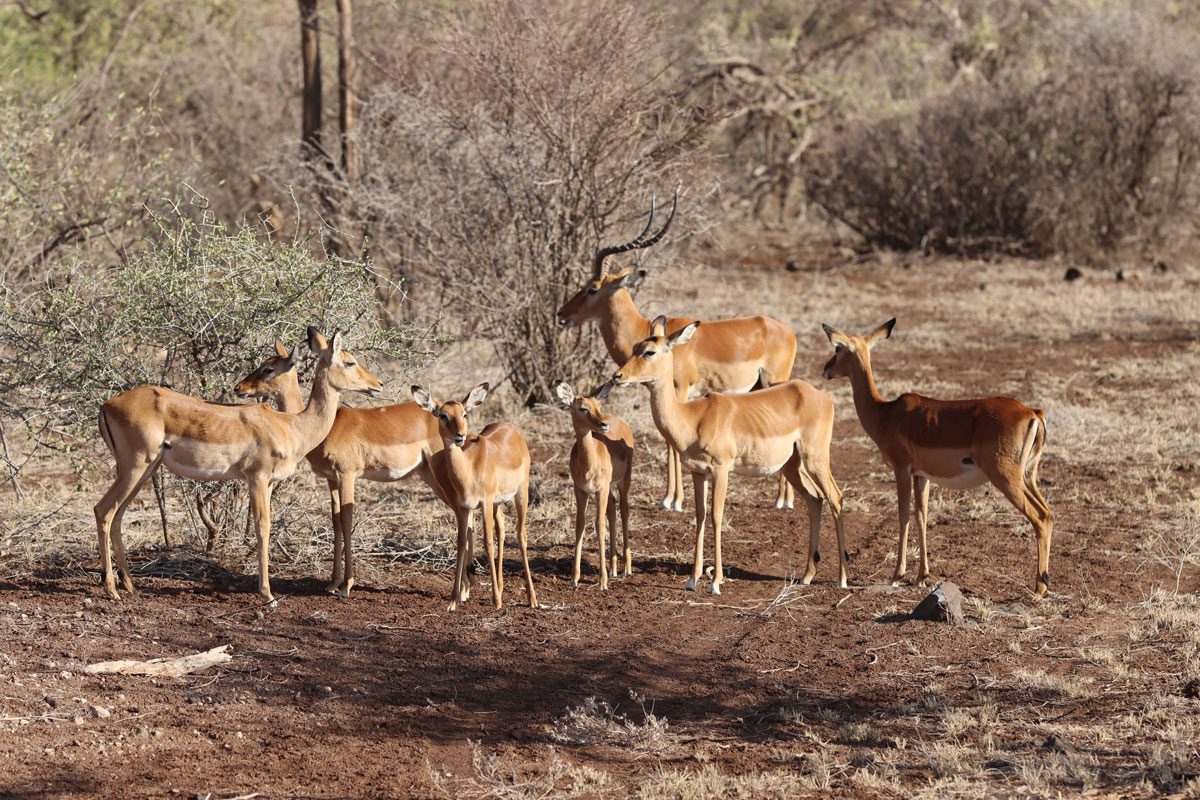
Impala – These antelope are abundant in Samburu. Usually one male is surrounded by a harem of females. They are easy to recognize by what looks like a black “letter M” marking on their backside.
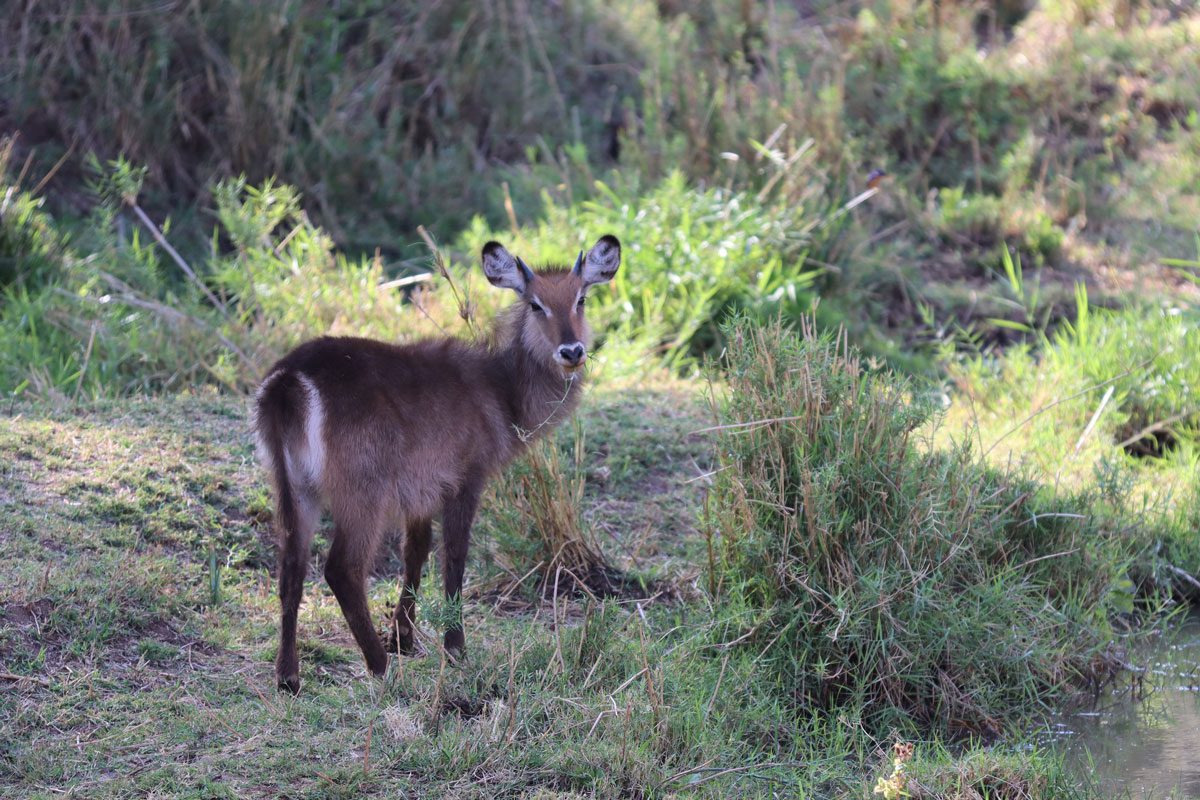
Waterbuck – A large antelope with a shaggy brown-gray coat that tends to live near a water source.
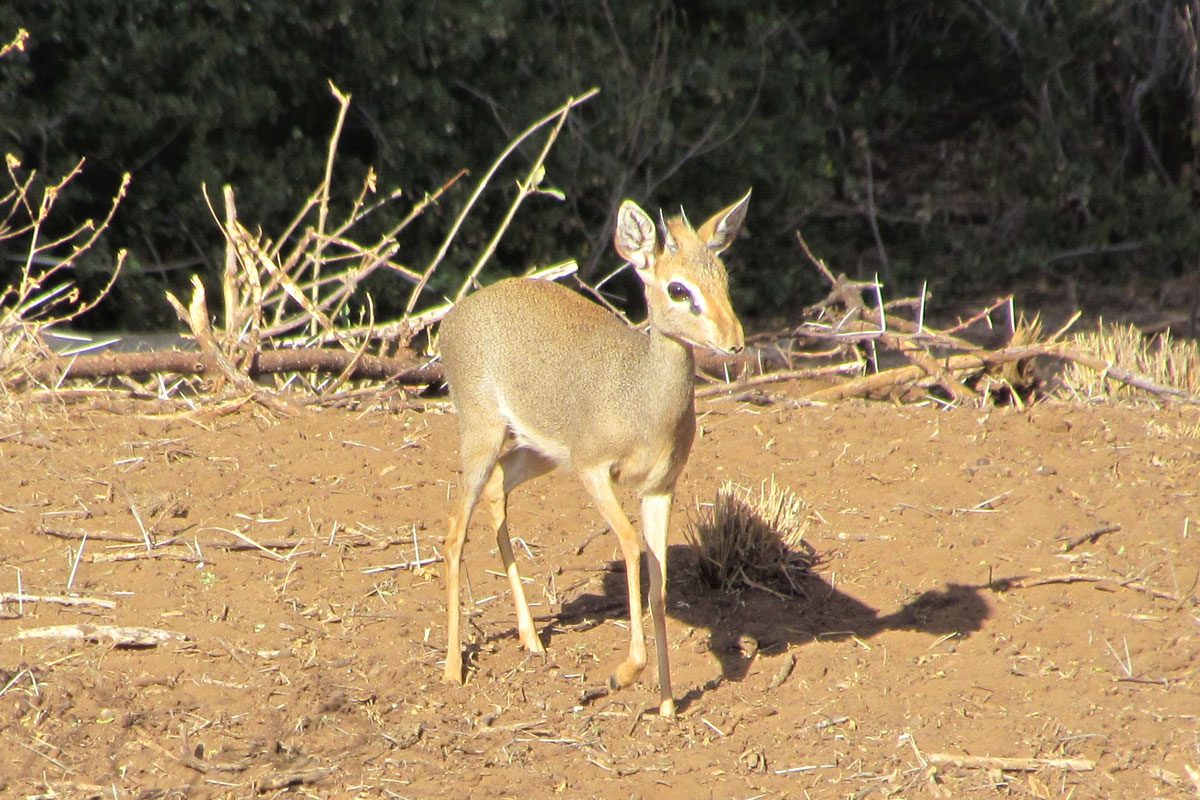
Kirk’s Dik-Dik – A tiny Antelope (only 12-16″ tall & 6-13lbs!) that you’re most likely to find hiding in bushes. Dik-diks are monogamous and can usually be found in pairs.
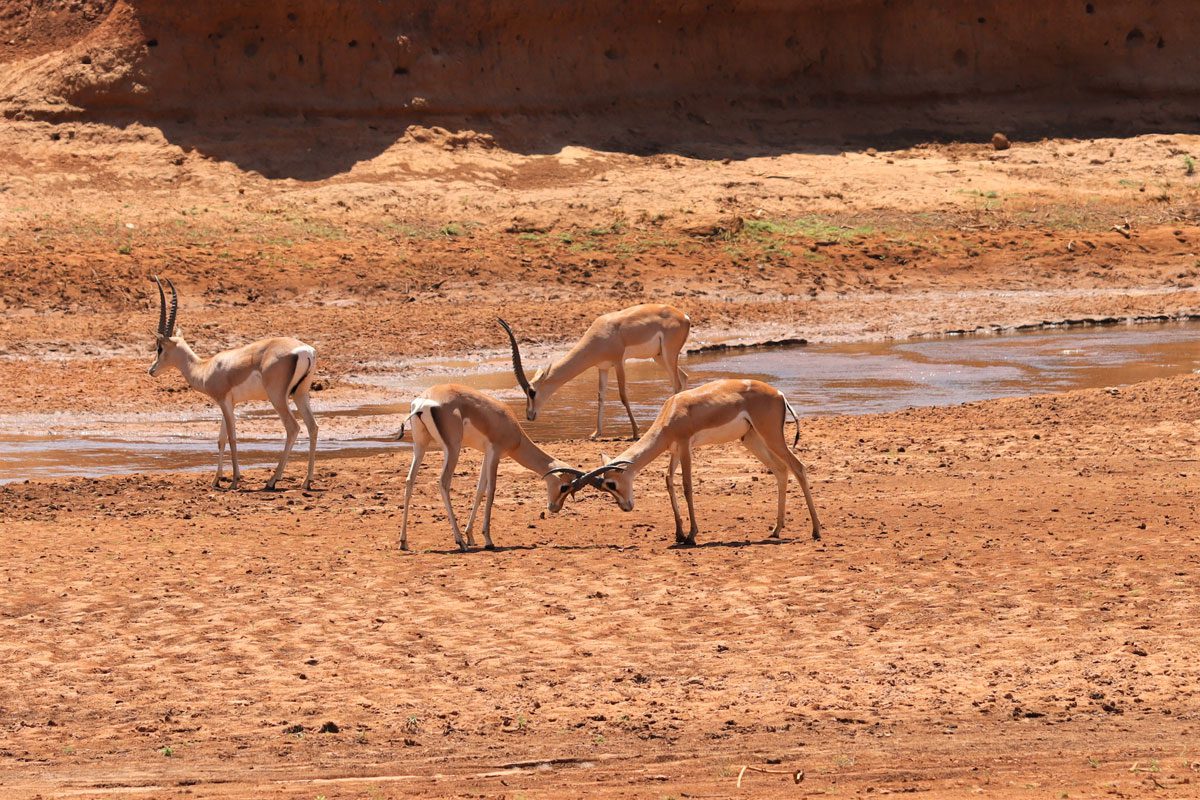
Grant’s Gazelle – Abundant in Samburu, these antelope are easy to distinguish due to the white patch on their backside that extends slightly above their tail. Here we saw them battling!
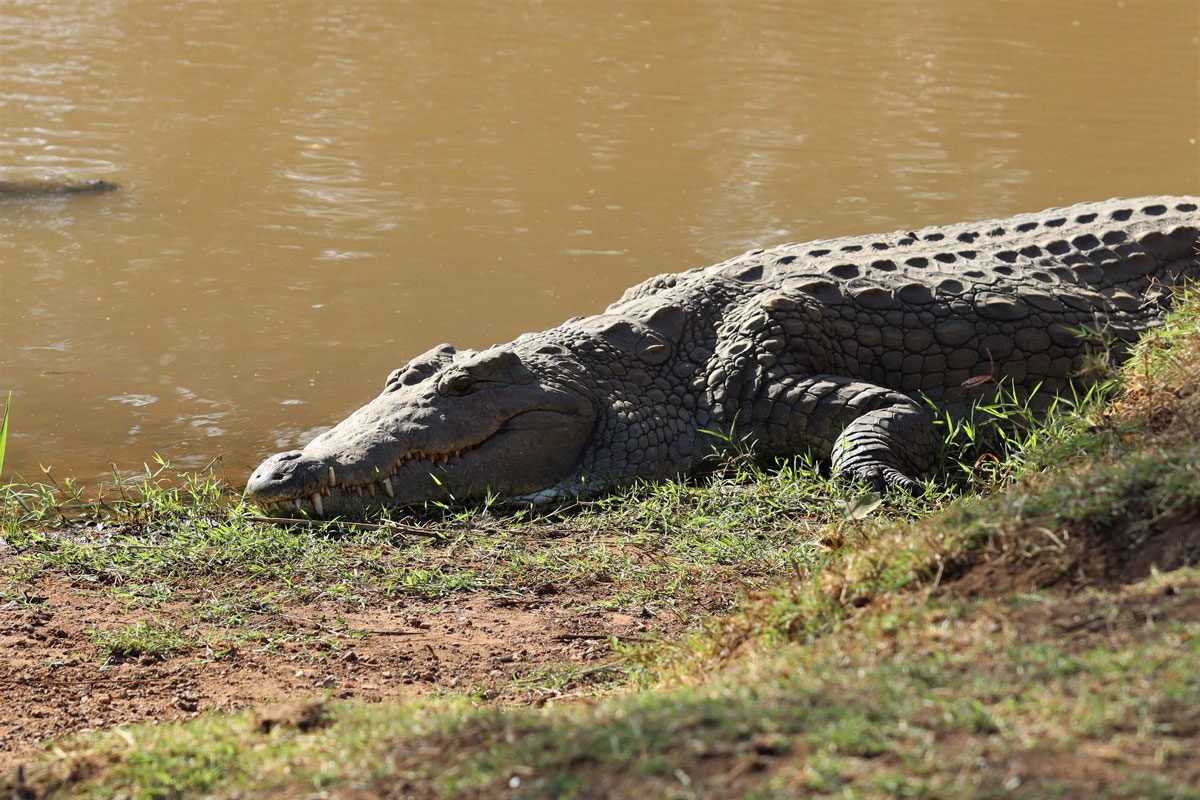
Crocodile – Look for crocodiles along the banks of the Ewaso Ngiro River.
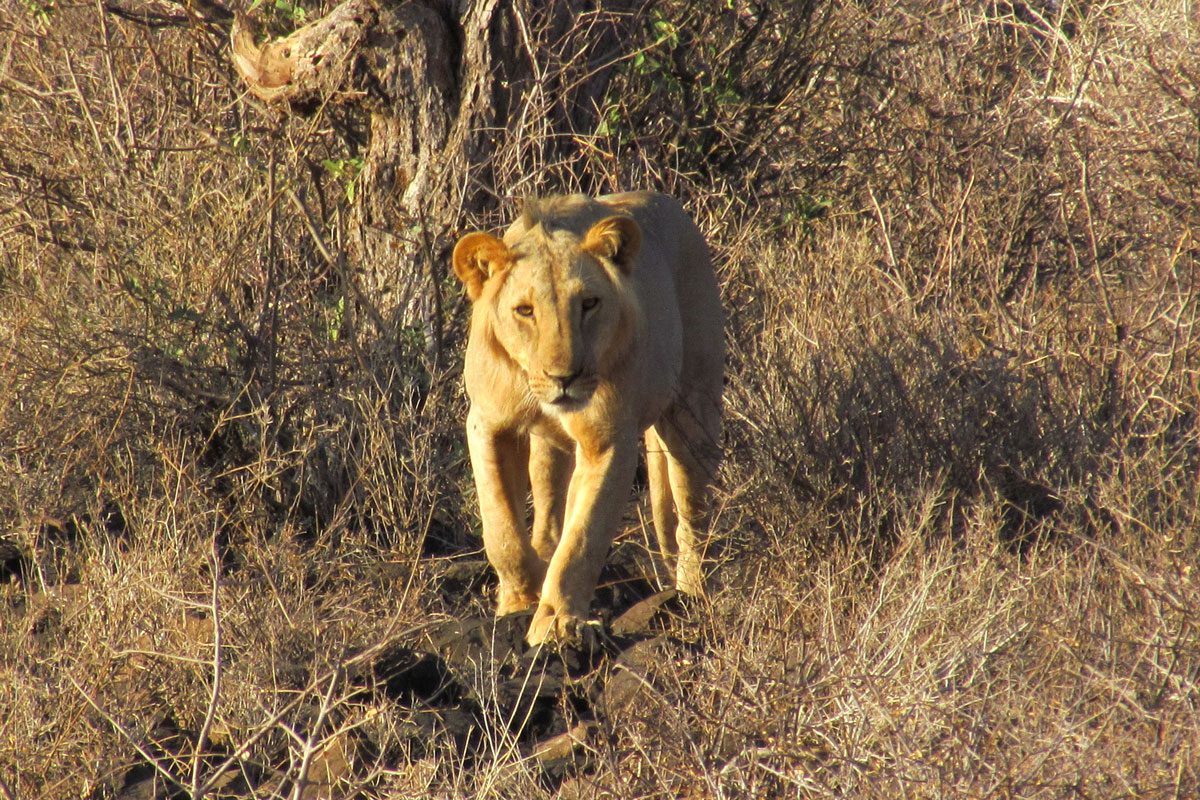
Lion – We saw only one group of three lions during our time in Samburu on this trip. (On a past trip, several years ago, I saw many more here.)
Unique African Birds in Samburu & Buffalo Springs
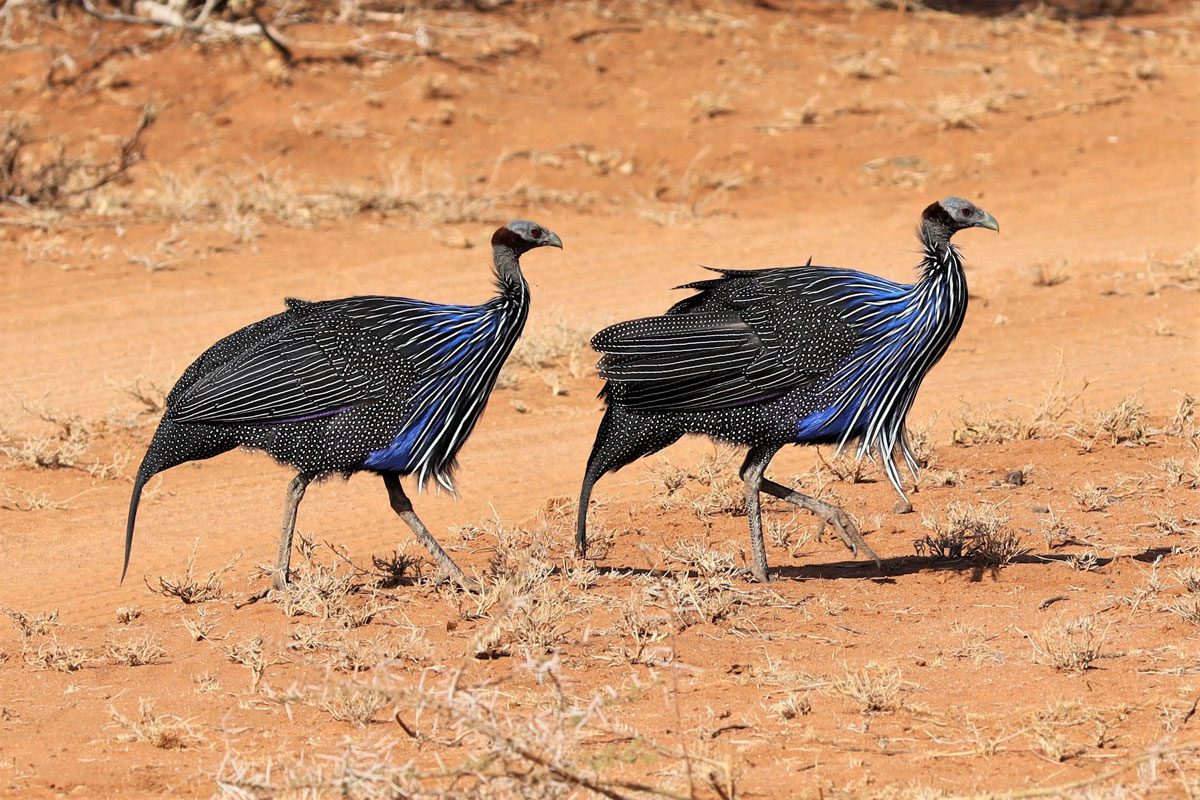
Vulturine Guineafowl – A striking guinea fowl with a brilliant blue breast and bald head. I thought these birds were gorgeous!
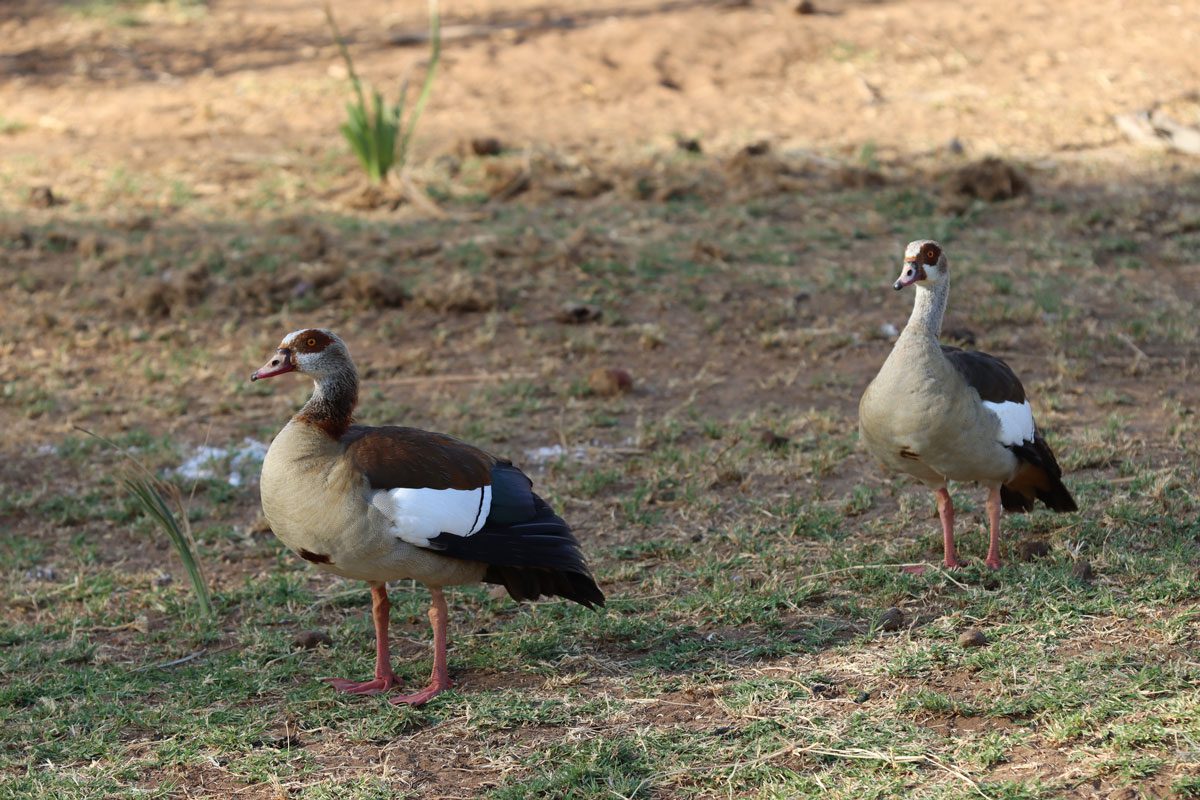
Egyptian Geese – Beautiful geese that were considered sacred by the Egyptians and appeared in much of their artwork.
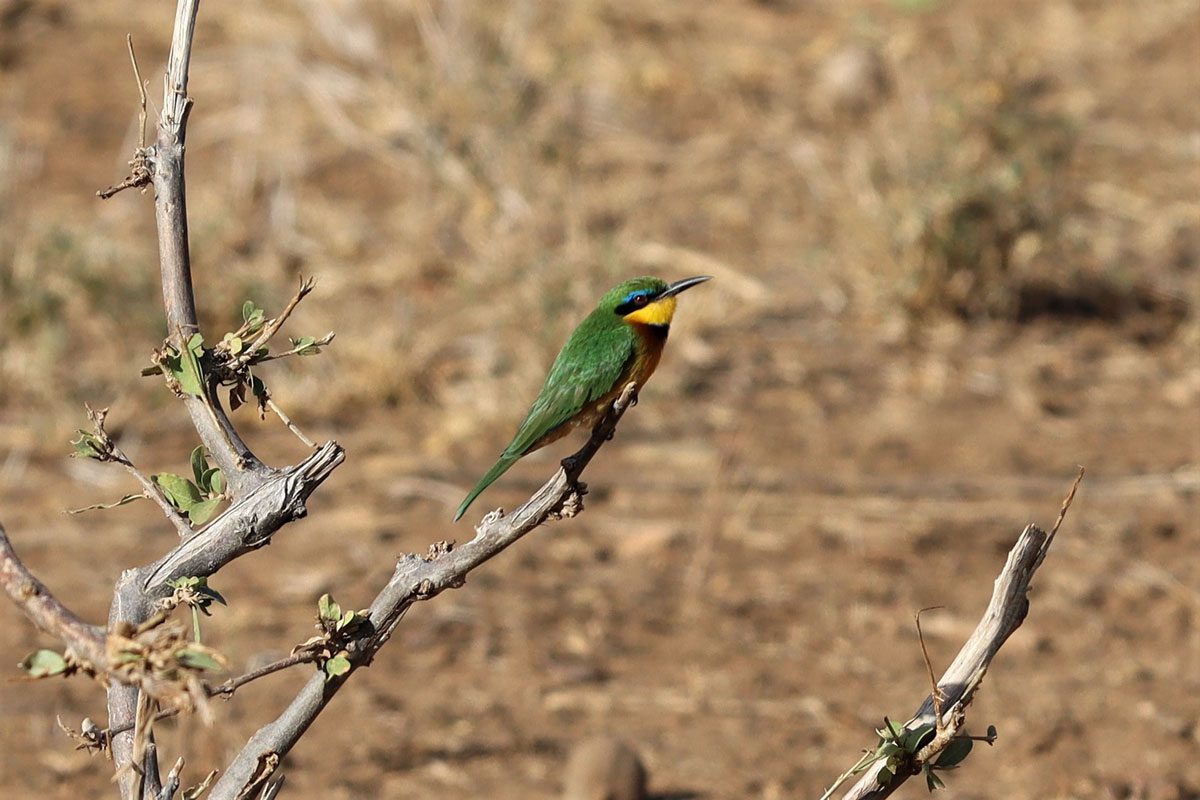
Little Bee-Eater – Gorgeously colored small bird that primarily eats insects and lives all throughout central Africa.
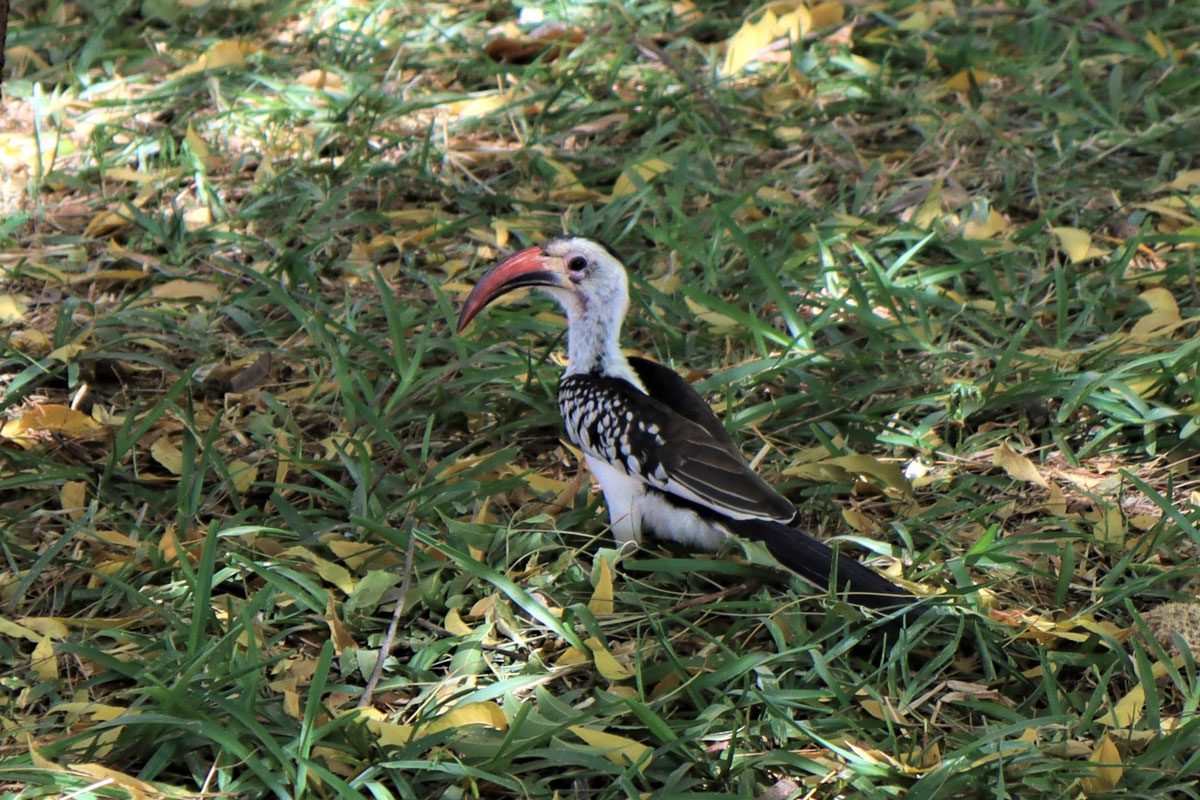
Red-billed Hornbill – a smaller hornbilled bird that Zazu from the movie The Lion King was characterized after!
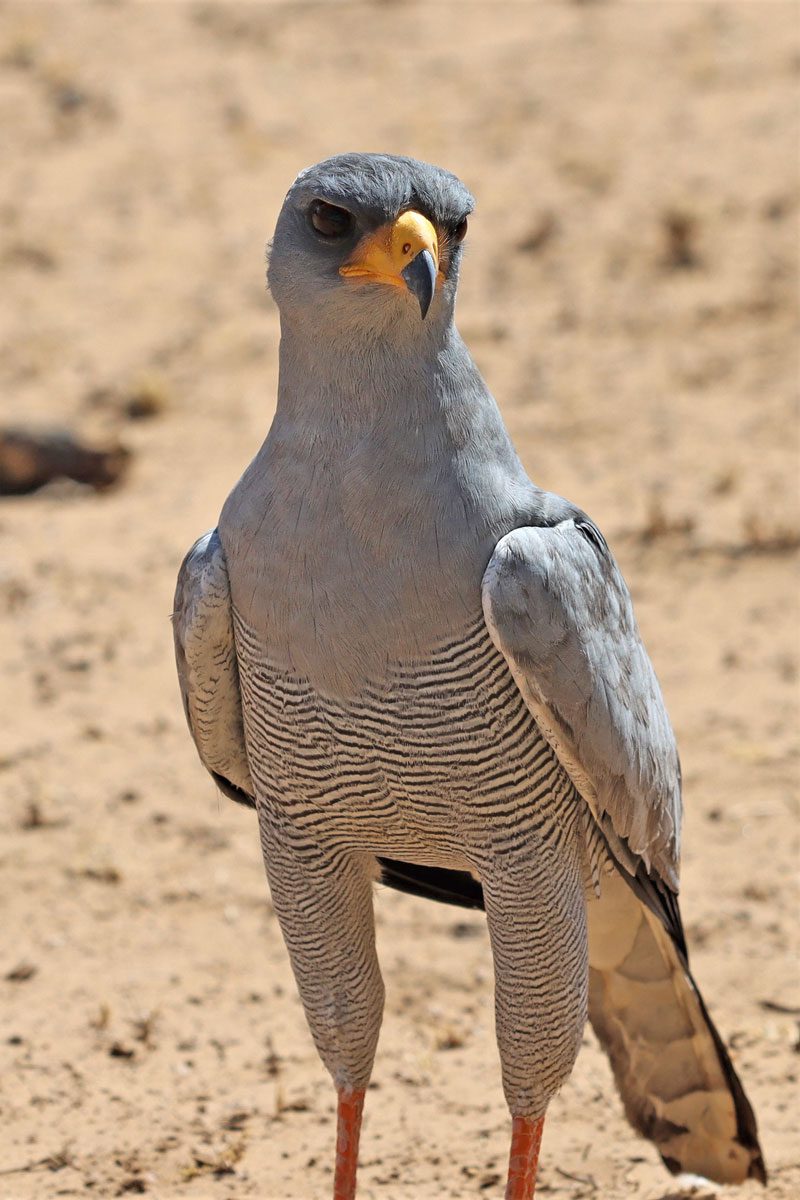
Pale Chanting Goshawk – I love how this unique hawk looks. It looks like it’s wearing pants!
Unique & Adorable Moments
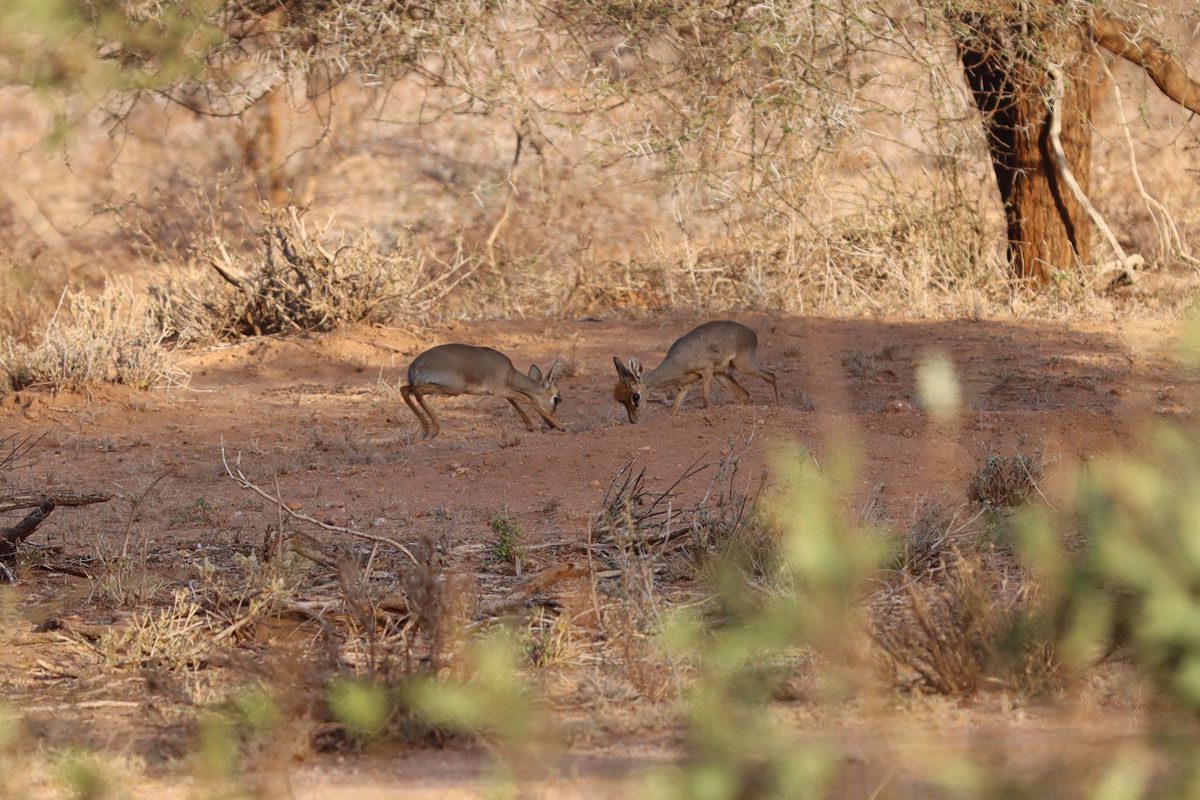
Two Male Dik-Diks Battling It Out. This is supposedly a pretty rare event to see, and it was almost adorable to watch because they are so tiny!
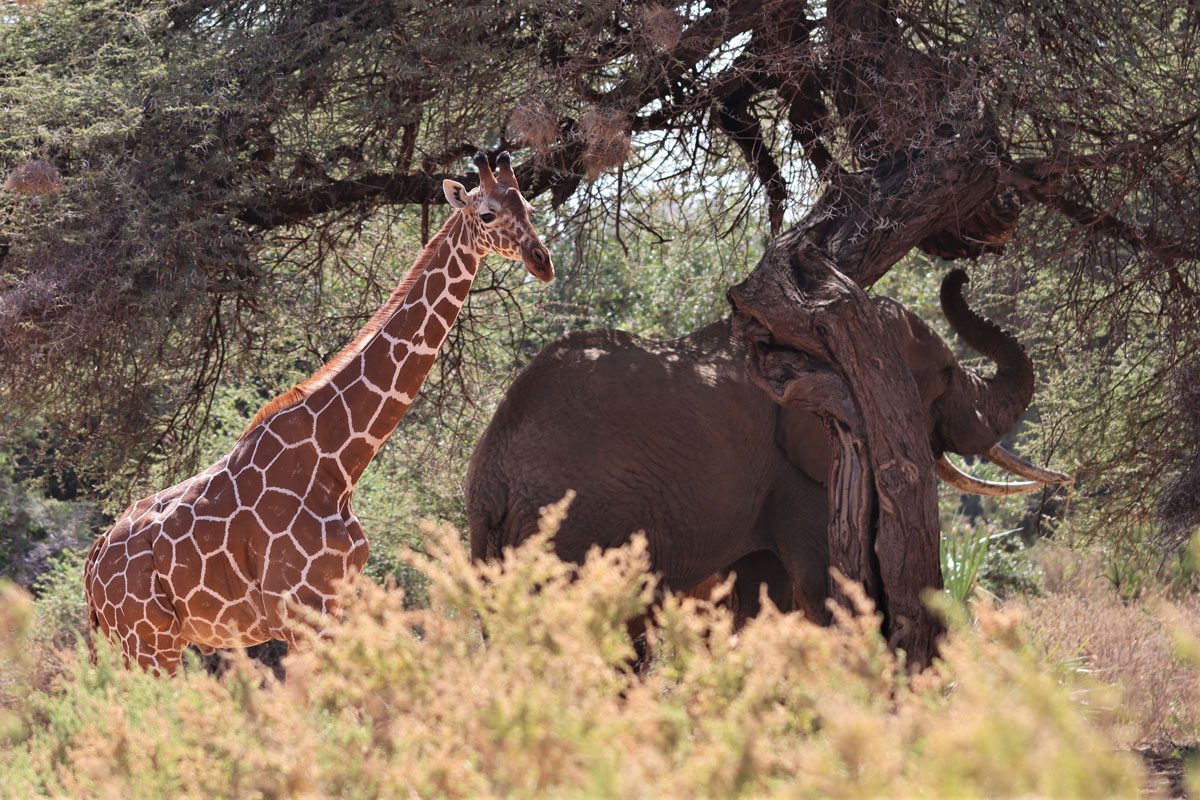
Elephants and Giraffes Just Hanging Out Together! I loved seeing different species happily living together.
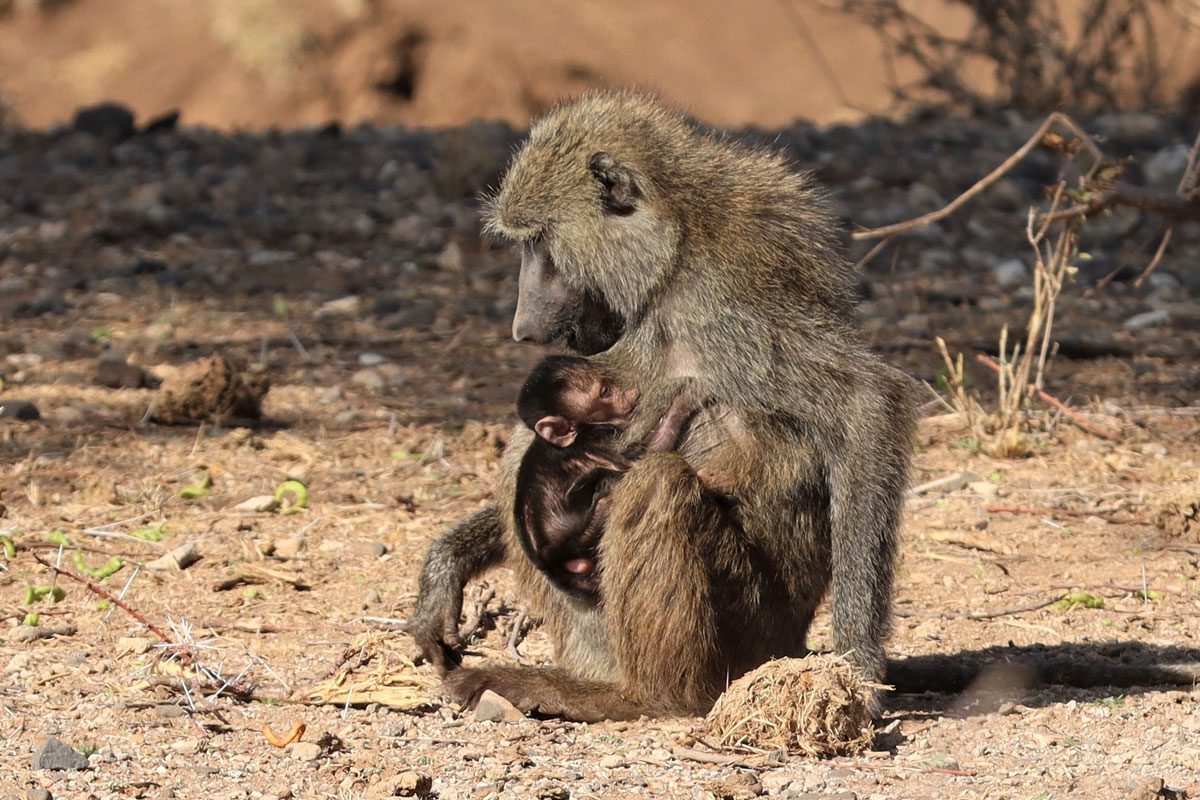
Baboons – We saw this mother baboon nursing her tiny adorable baby.
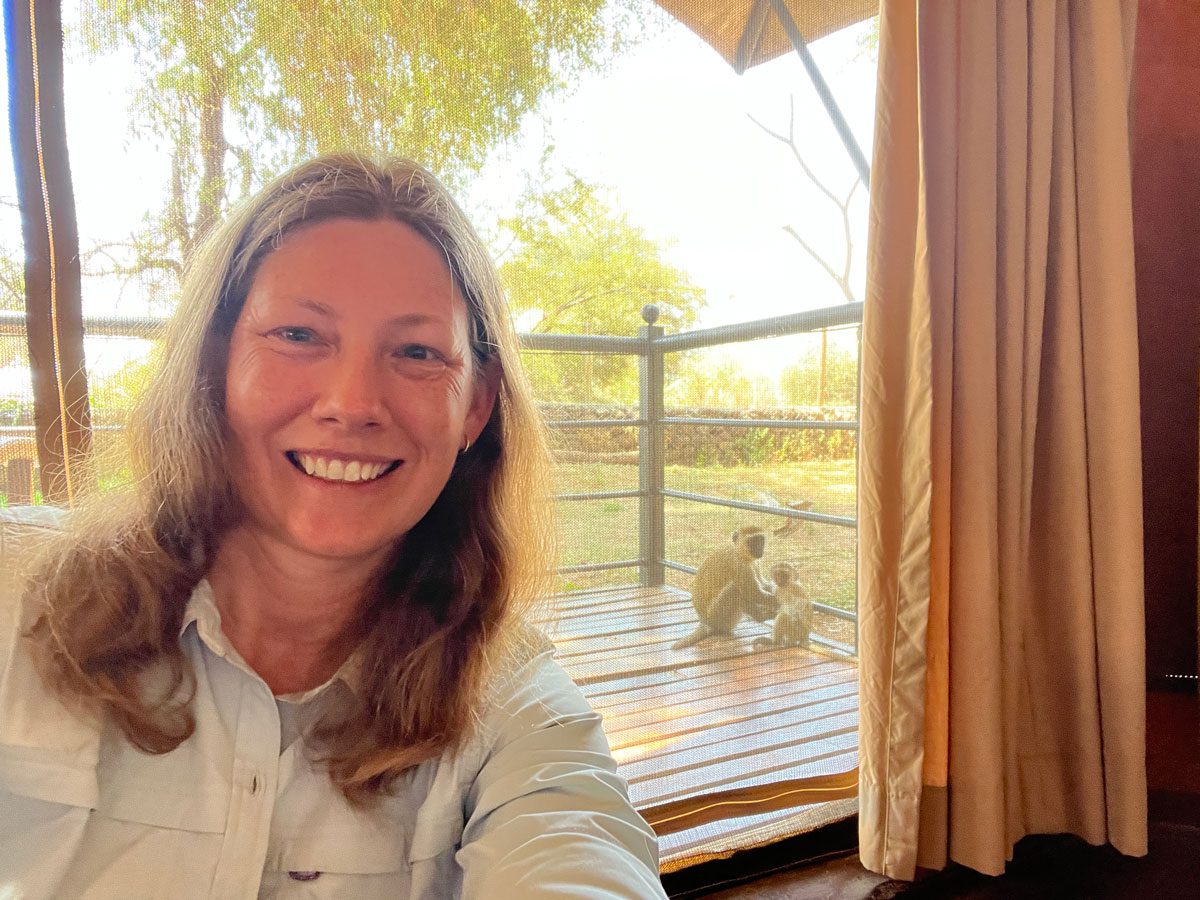
Vervet Monkeys Played Right Outside My Room at Ashnil Samburu Camp!
Sunset in Samburu National Reserve
After our evening safari through Samburu we were awarded with this picture-perfect African Sunset.
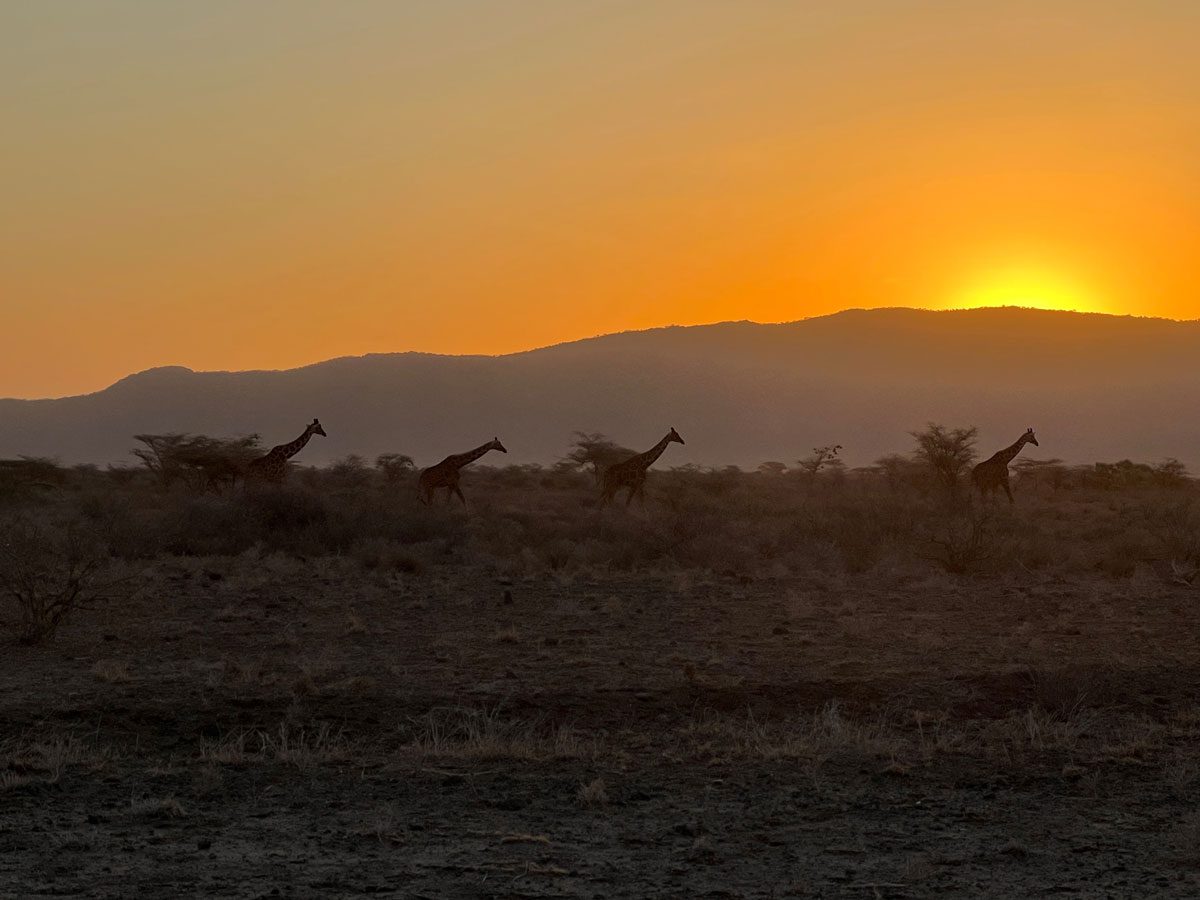
To me, the picture above was like something out of National Geographic. It felt completely unreal! But here we were, looking at this beautiful sunset with giraffes walking on the horizon, and just trying to comprehend how in fact this amazing place really does exist.
HOW LONG TO VISIT SAMBURU & BUFFALO SPRINGS?
Our family spent 2 full days and 3 nights in the Samburu area and I think that this is an ideal amount of time, especially since our family was trying to see multiple parks throughout Kenya with only a few weeks to visit. (Though I could have easily stayed longer if we had more time available to us.)
With 2 full days our family was also be able to spend some time at the nearby Samburu Tribe Village as well. This would be a great addition to any safari schedule in the Samburu area.
IMPORTANT TO KNOW BEFORE YOU GO
There is one issue with Samburu that you may want to check into before you decide to visit, and that is its drought status.
When we visited Samburu in July of 2022, Samburu had not received rain in over 2 years!
The ground was insanely dry and desert-like. And it was a very different safari experience compared to that of southern Kenya.
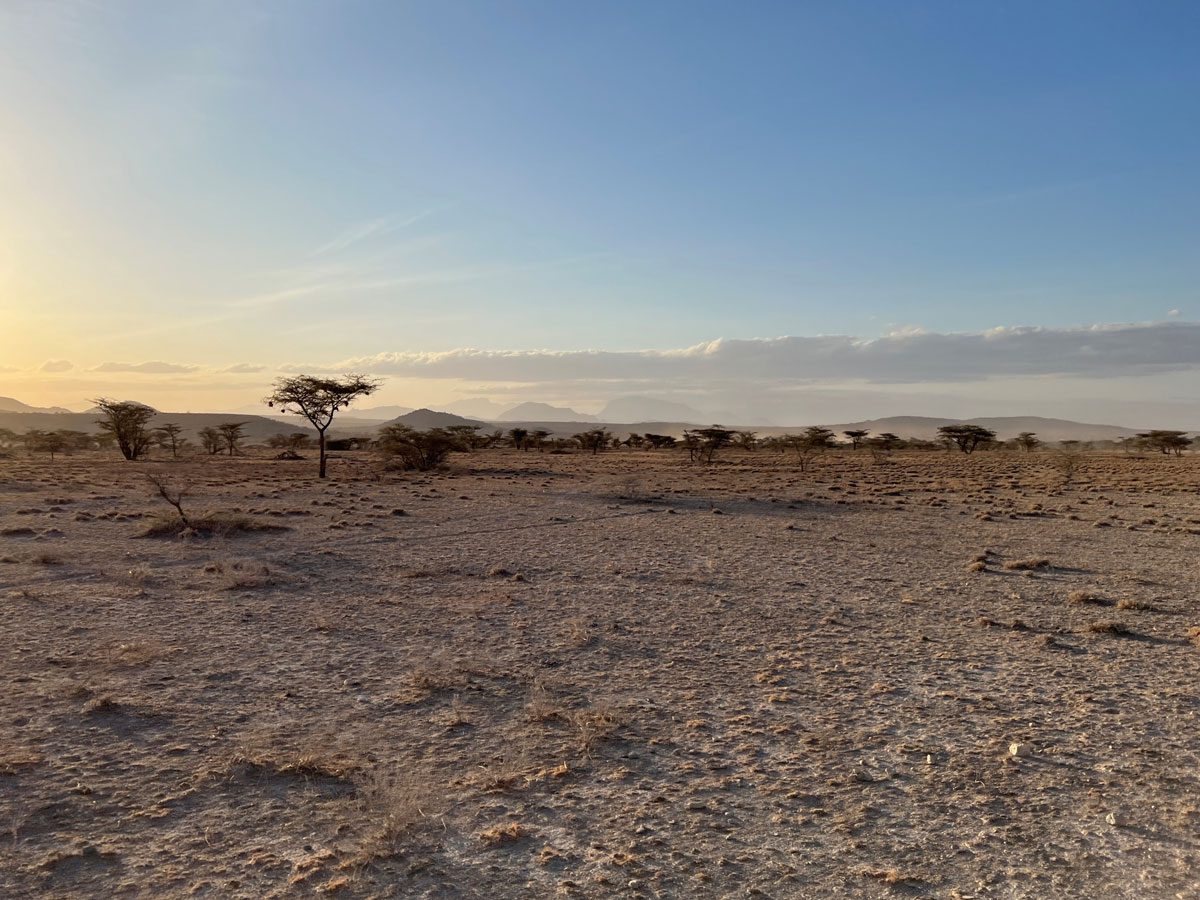
And although we saw a ton of animals here (and a lot of rare and endangered animals), it was much less than when I had previously visited several years ago.
On this trip we did not see any leopard or cheetah or wild dogs, all that I had seen previously here, and we only saw one group of lions. Maybe our luck just wasn’t as good on this 2-day safari or maybe the drought stricken landscape is taking a bigger toll on the animals that live here than I had realized.
I sincerely hope that the rains will return to Samburu soon.
Samburu needs it desperately.
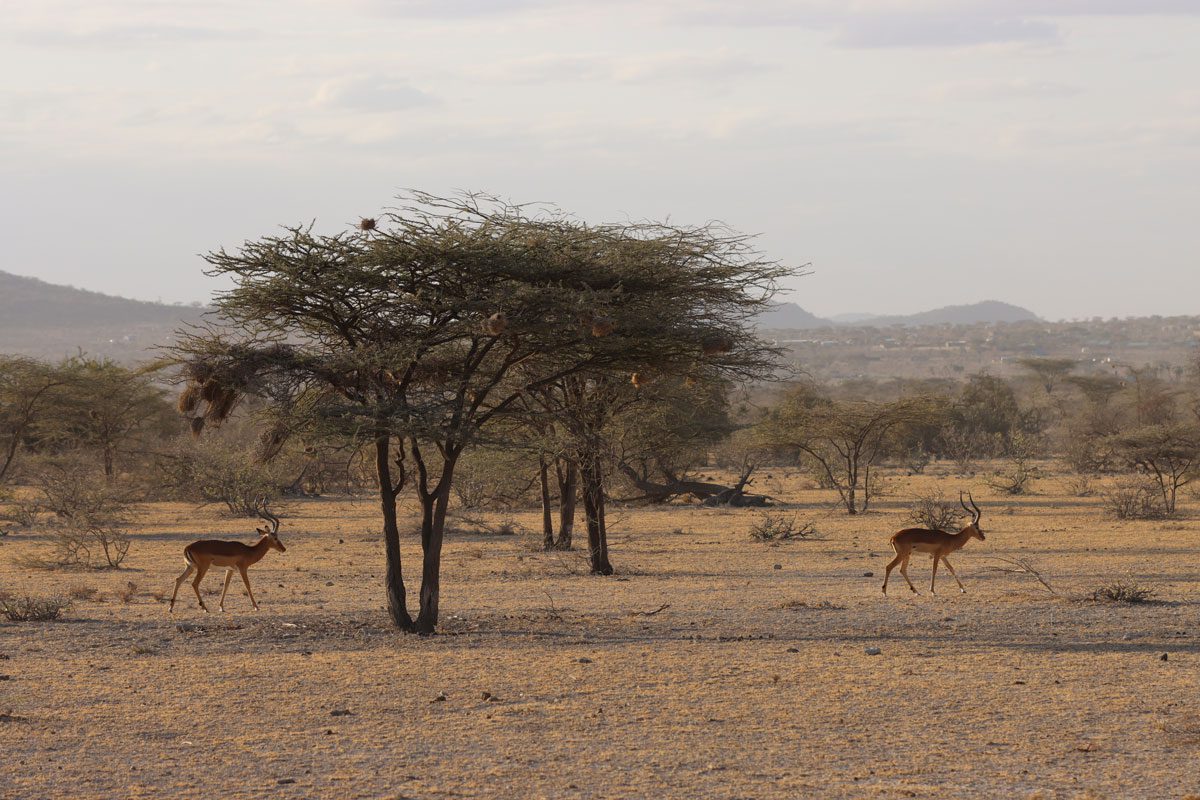
But even with the drought, I am so happy that our family was able to visit Samburu and Buffalo Springs. Yes, this dry landscape created a very different safari atmosphere for us and yes, I am sad that we did not see more of the Big Cats or the Wild Dogs, but what we did see was incredible.
We saw animals that cannot be found anywhere else in the world, had elephant encounters that completely took my breath away and had a safari experience that I will treasure forever.
Samburu National Reserve and Buffalo Springs Truly Are Top Safari Destinations That You Won’t Want To Miss!
WHAT TO BRING ON A SAFARI?
- Water (Bottled water since the tap water is not safe to drink.)
- Snacks
- Binoculars
- Bushnell H2O Waterproof/Fogproof Compact Roof Prism Binocular – Our Favorite lightweight/ compact binocular with fantastic optics
- Bushnell H2O Roof Prism Binoculars – Bigger & easier to hold with less image jiggle, outstanding optics, plus you can hold a cell phone up to the lens to capture a picture with a wonderful extra zoom!
- Sun Hat (This is our favorite.)
- Sun Screen
- Pocket Animal Guide (We like this one best.)
- Camera – preferably one with a good zoom if you can
- The Camera we use – a fantastic investment
- Our Zoom Lens – for amazing close up shots
- And Our Camera Backpack – this is the best camera bag ever! And we’ve tried out a lot.
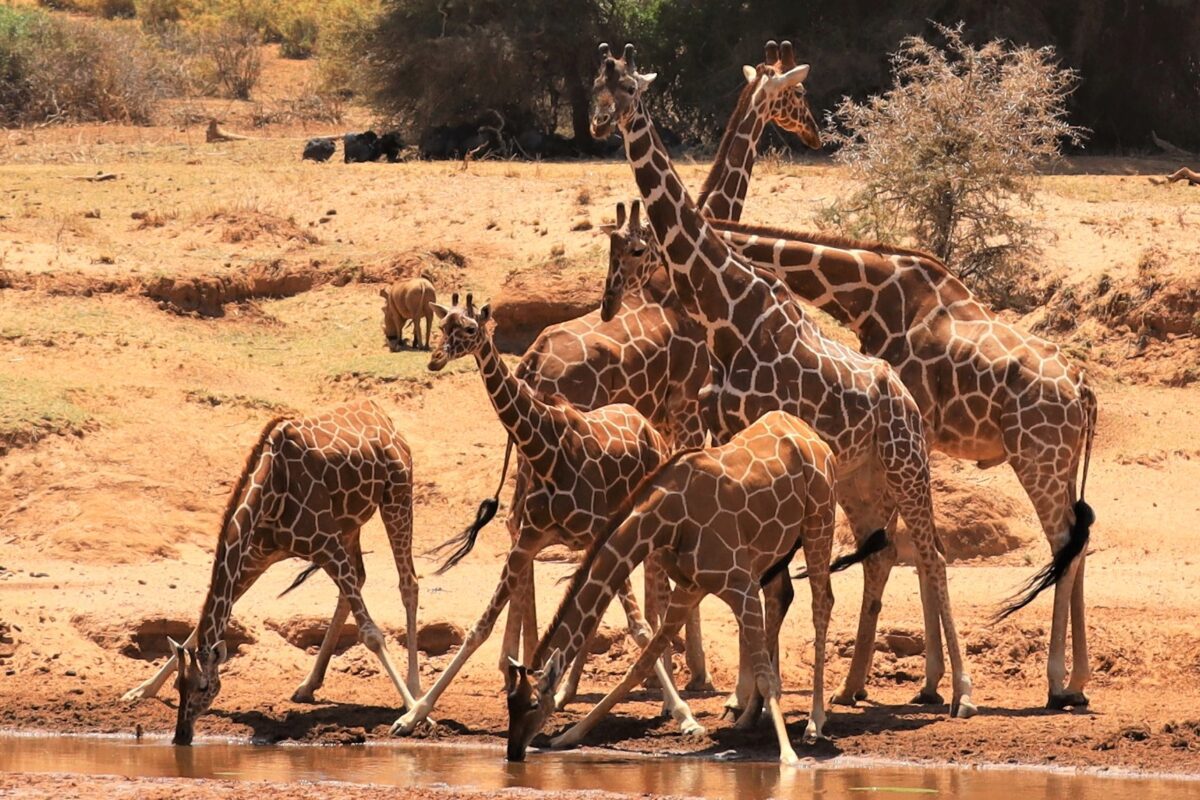
From the scenery that we saw like this…
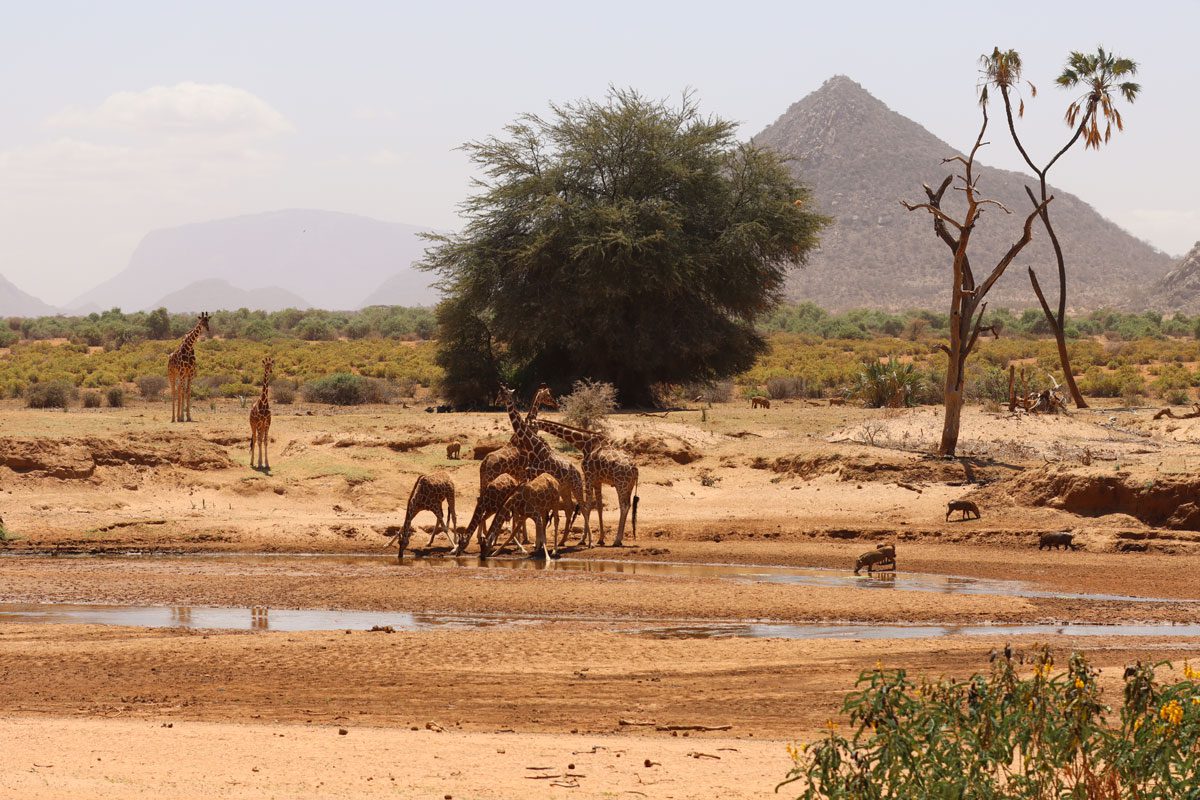
Photography Tip: We only carry a 200 zoom lens of high quality, and then when we get home we crop the picture to get an even greater zoom effect. For us, this has worked better (and is cheaper) than trying to carry an extra 400 zoom lens to try and get those amazing close up shots.
POPULAR TOURS TO SAMBURU
If you are looking to create your own customized tour – check out Journeys International. This is who we used and they were amazing!
FUN “ROAD TRIP STOPS” BETWEEN NAIROBI AND SAMBURU
- Lunch at The Trout Tree Restaurant – This is a fun restaurant set up in a tree, with incredible fresh trout (that is farmed onsite, in pools right below the restaurant.)
- Animals we saw here: We saw a Tree Hyrax here and two Colobus Monkeys were just hanging out in the parking lot!
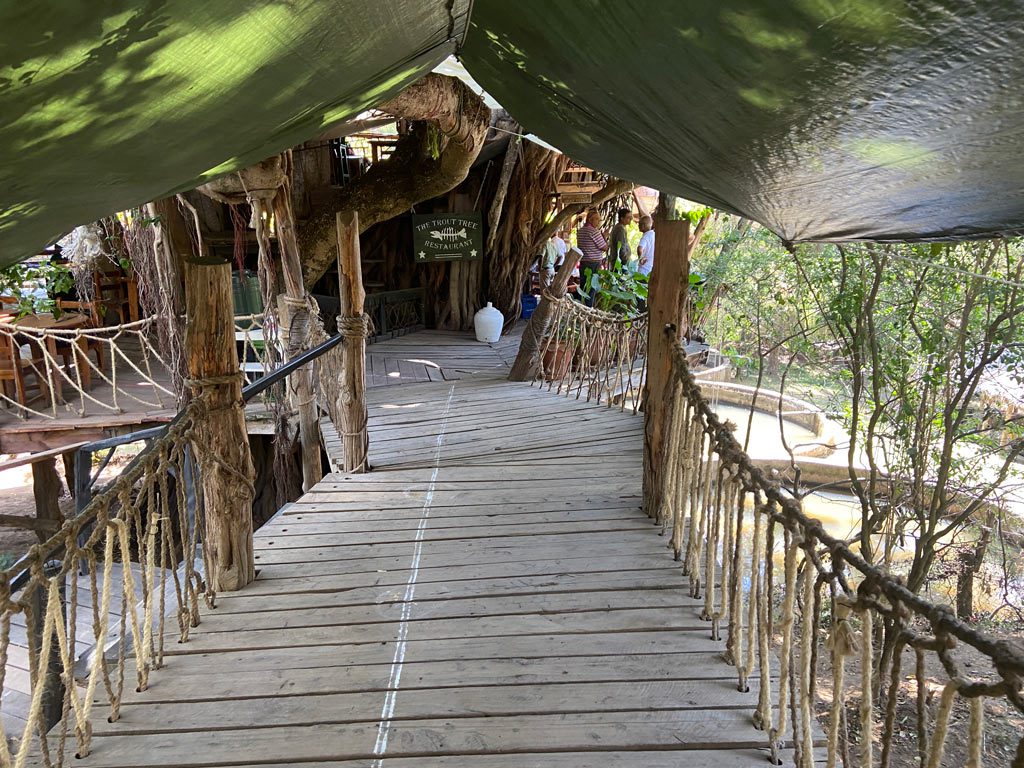
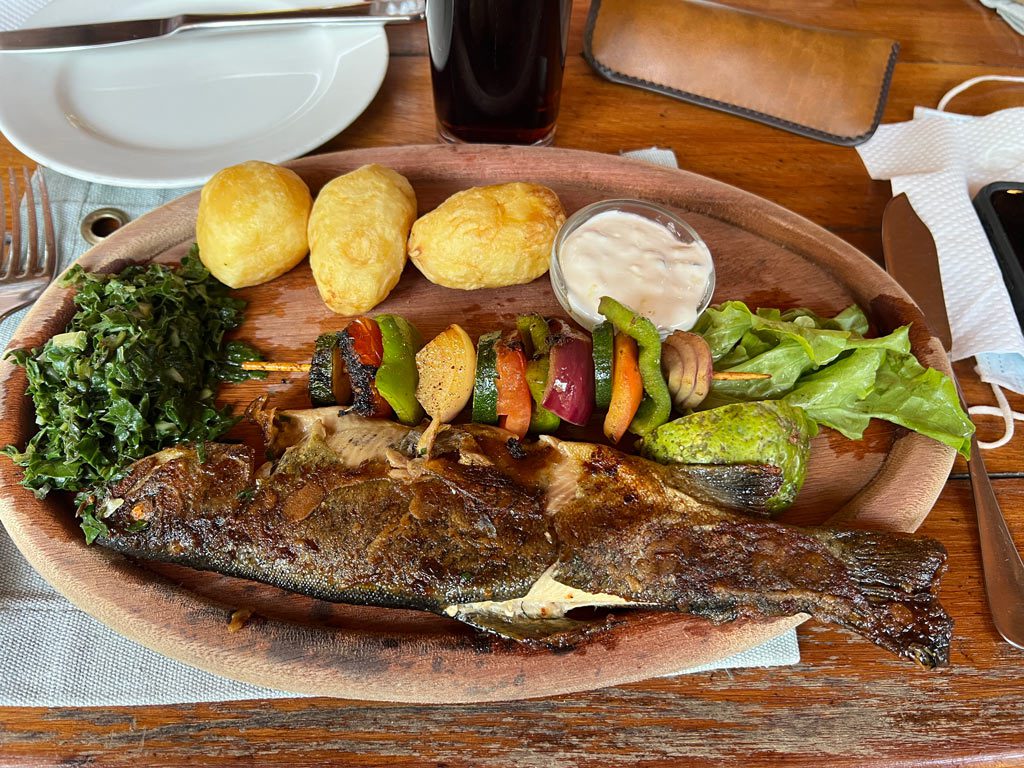
- Ol Pejeta Conservancy – This is the largest black rhino sanctuary in East Africa and home of the last 2 remaining northern white rhinos. You can also take a quick safari and see numerous other animals here. Our family really enjoyed visiting this site.
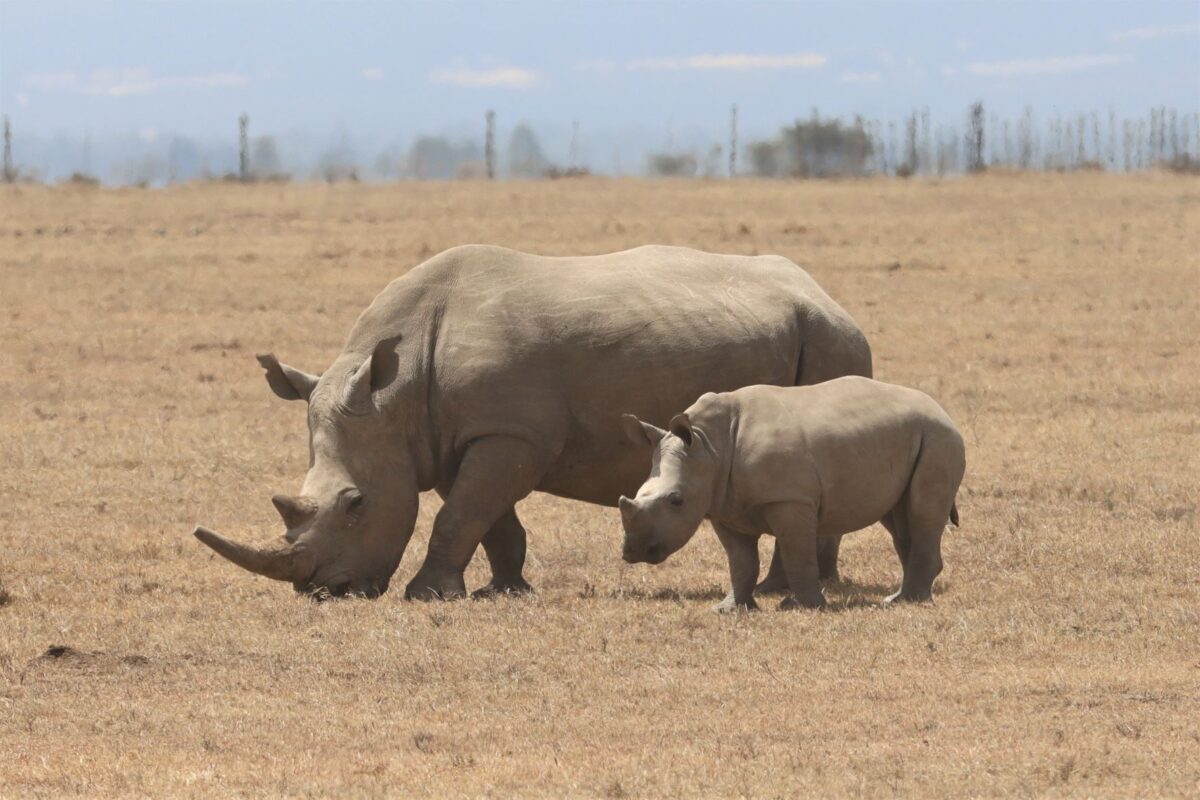
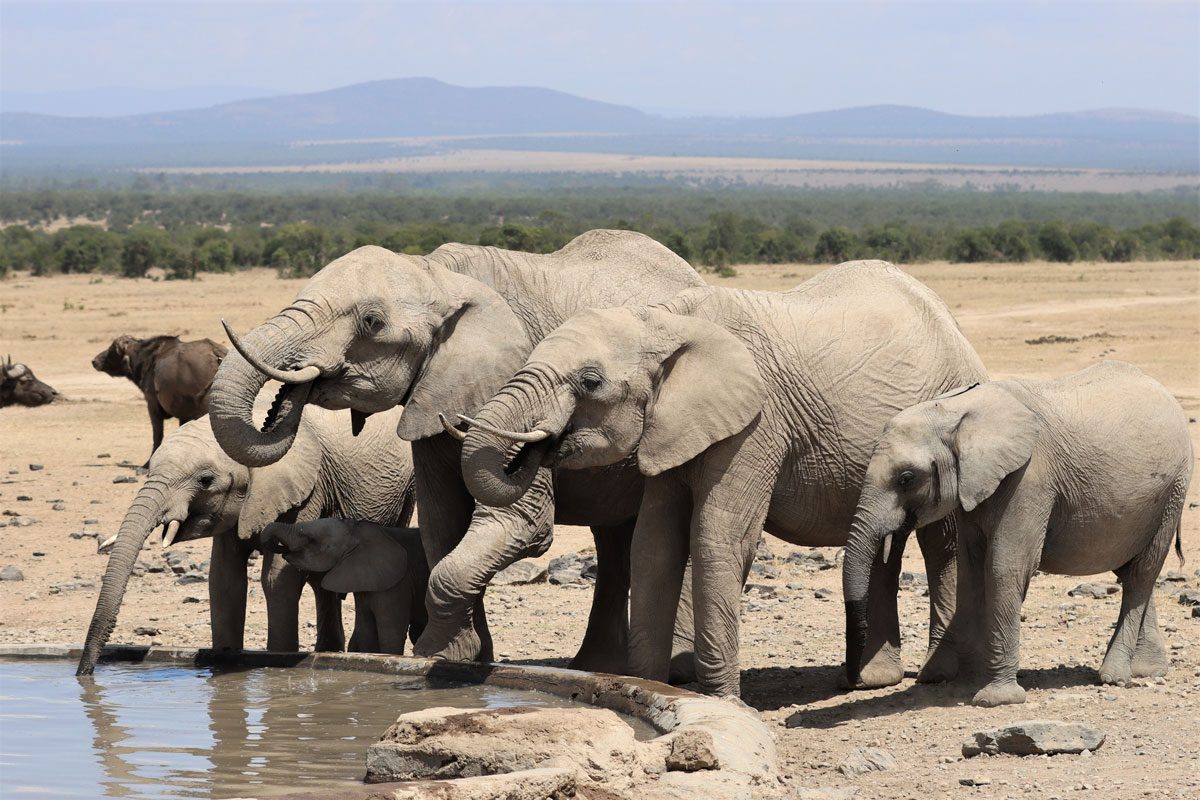
- The Equator – This is a bucket-list stop. We stopped at the equator at Ol Pajeta and thought that it was set up there really nice.
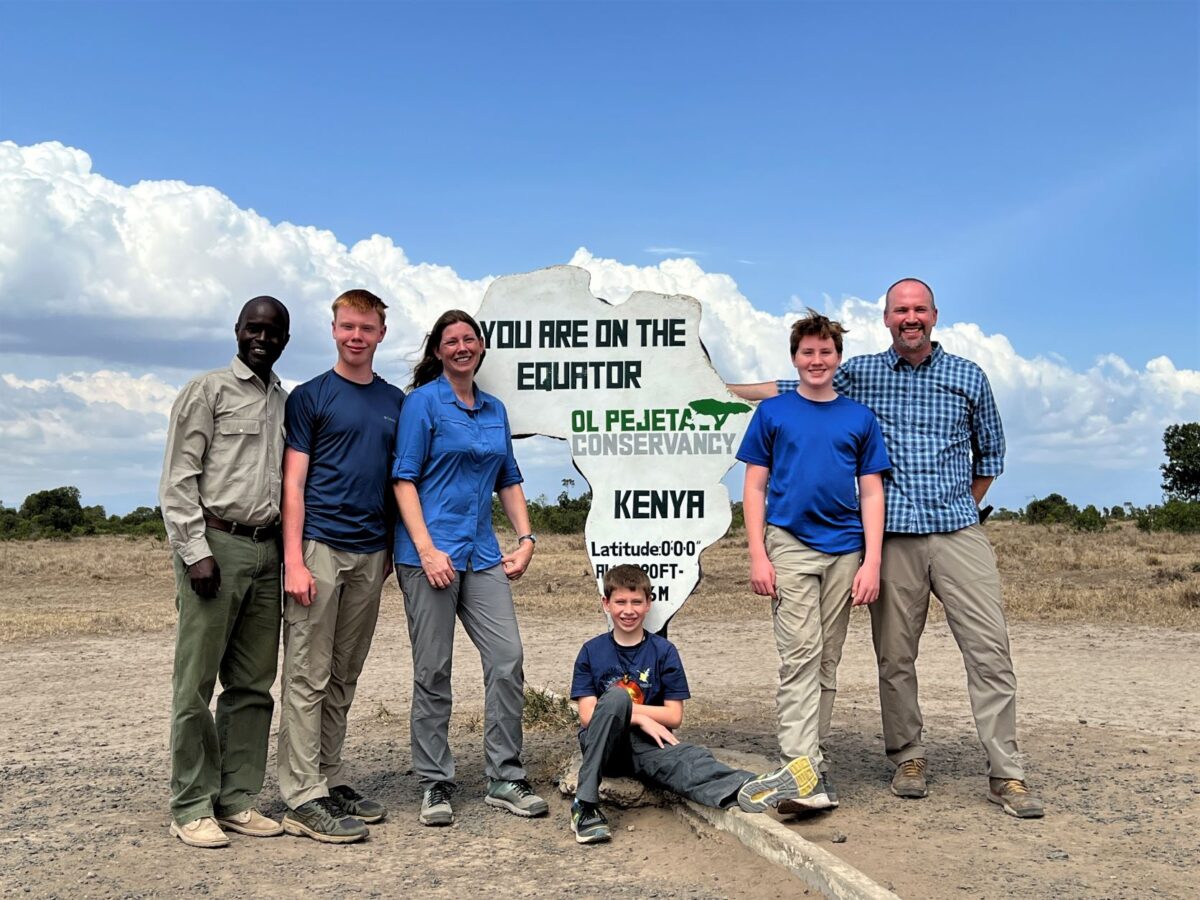
Now you are all set to visit Samburu National Reserve and Buffalo Springs. I hope you found this post helpful and that you learned a little as to why these two reserves are so special. Please let me know if you have any questions or comments below.
Have a Great Safari in Samburu National Reserve & Buffalo Springs with Your Traveling Feet!
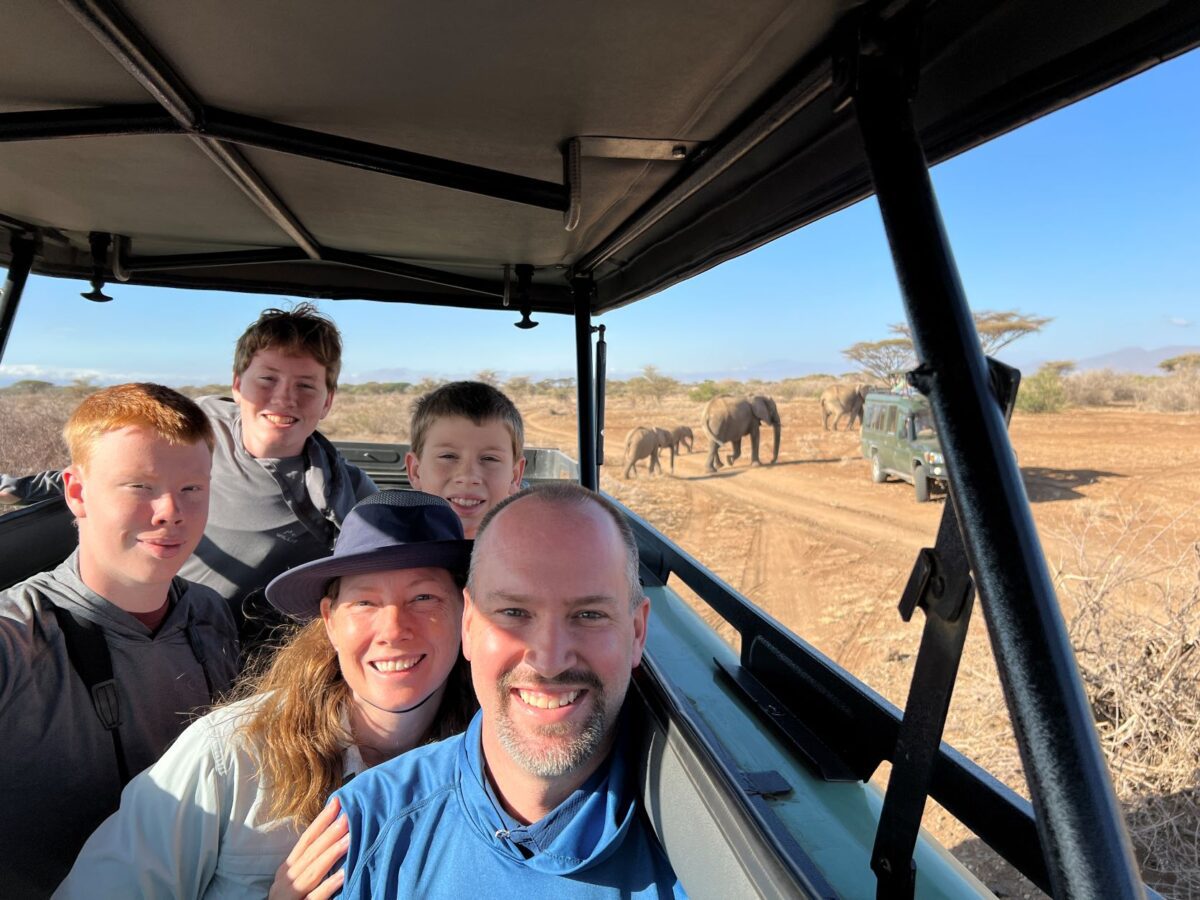
If You Found This Post Helpful, Please Share / Pin It
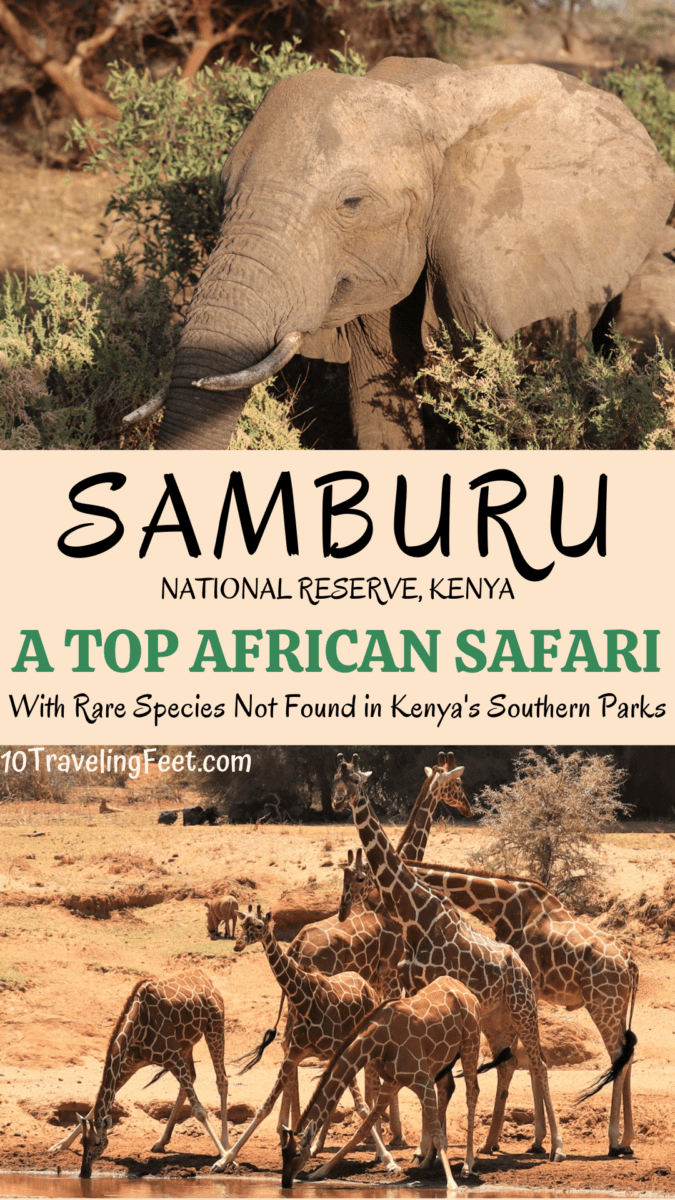
10 Traveling Feet is a participant of Amazon Associates which means means we may receive a small commission, at no cost to you, if you make a purchase through a link. Thank you for supporting 10 Traveling Feet.

